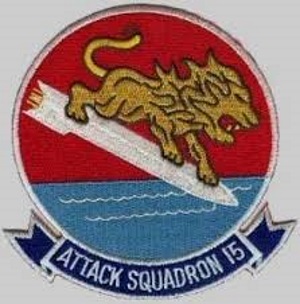 |
VA-15 (1967)
Our Second Vietnam Deployment Updated January 29th, 2025
|
This update includes descriptions of the missions that I have received so far from my VALion shipmates.
I will include additional VA-15 missions as I receive them.
VA-15 Circa 1967 Began When the Magic Carpet Flight Arrived at NAS Cecil from Cubi Point about October 22nd, 1966
There was quite a crowd of wives,
children, girlfriends, and various friends
that celebrated our magic carpet flight back
home. Most of the VALions walked off the
airplane. A few were carried. The flight
attendants had kept the champagne and other
drinks coming all the way home. We all went
on basket leave various places for a few
weeks. Many of us had to be back in Mayport
to meet the ship in late November to
fly our aircraft back to Cecil.
Mary, Heather, Laura and I spent some time in Ridgewood with my family and in Duxbury with Mary's family. Heather was almost three, Laura almost two. It was the first time since I started flight training fours years earlier that I was able to spend any time at home. We had a lot of catching up to do.
Intrepid arrived in Mayport about November 19th or 20th. I think the ship craned our aircraft off. My log book shows that I flew A4B 145001 from Mayport to Cecil on November 21st. We took a brief break for Thanksgiving and then got back to business.
I flew four TF9 Cougar instrument flights with VA-45 (November 29th and 30th, and December 1st and 2nd) to renew my instrument card.
Instrument round robins were flights that we flew solo or in section where we followed a flight plan to another airfield, flew a TACAN approach and a GCA and then refilled back to Cecil when we completed the approach. This procedure had a fatal flaw. If you had a radio failure and were flying solo, you were required to land at the airfield. Normally, the squadron didn't actually file a flight plan so the destination airport didn't know we were coming. This produced a very humorous but almost dangerous situation on one flight.
Mary, Heather, Laura and I spent some time in Ridgewood with my family and in Duxbury with Mary's family. Heather was almost three, Laura almost two. It was the first time since I started flight training fours years earlier that I was able to spend any time at home. We had a lot of catching up to do.
Intrepid arrived in Mayport about November 19th or 20th. I think the ship craned our aircraft off. My log book shows that I flew A4B 145001 from Mayport to Cecil on November 21st. We took a brief break for Thanksgiving and then got back to business.
I flew four TF9 Cougar instrument flights with VA-45 (November 29th and 30th, and December 1st and 2nd) to renew my instrument card.
The
December Flight Schedule
I flew 14 A4 flights
in December. The squadron began
flying A4Bs in instrument round robins
and weapons training flights.
Instrument round robins were flights that we flew solo or in section where we followed a flight plan to another airfield, flew a TACAN approach and a GCA and then refilled back to Cecil when we completed the approach. This procedure had a fatal flaw. If you had a radio failure and were flying solo, you were required to land at the airfield. Normally, the squadron didn't actually file a flight plan so the destination airport didn't know we were coming. This produced a very humorous but almost dangerous situation on one flight.
Possum's famous
instrument round robin flight and my
flight to rescue him!
Christmas/New
Year's Holiday party at the
NAS Jacksonville Officer's
Club
On December 5th,
1966 Possum flew a solo round robin
flight to Turner Air Force Base, a
B-52 Strategic Air Command (SAC) Base
in Albany, Georgia. He had a radio
failure enroute so was forced to land.
The squadron had not forwarded his
flight plan so the Air Force folks
were unaware he was planning to
land. As a SAC base, security
was especially strict. Possum
had not brought his wallet with him
(wallets get sweaty in flight suit
pockets).
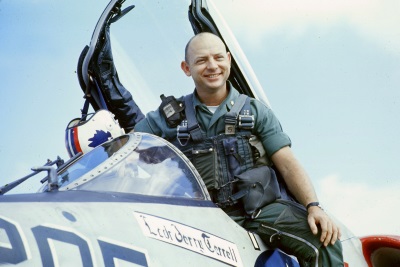 |
Possum had his name tag on his flight suit saying he was LCDR Jerry Terrell. He was flying aircraft 305 with his name on it (he was Rocket #5, the 5th senior pilot in the squadron) The folks at Turner AFB were not impressed! They let him call the squadron. Possum claims they kept him "spread eagled" and under guard near his airplane. But, I think it was more likely, they kept him in base ops once the squadron verified his story. |
I was called to
the ready room and was directed to get
an aircraft and file a flight plan
(the flight was not on the published
flight schedule) to go rescue my
flight leader. Just to be safe,
I found Possum's wallet in his locker
and brought his and my ID cards along
with me. I took off about noon. The
weather was clear but a bit cool. It
took me an hour to get to the
base. The first question they
asked me was whether it was my name on
my aircraft. I guess Possum
almost convinced the Air Force guys
that navy pilots only flew aircraft
with their name on it. They were
hesitant to let Possum take off with
an inoperative radio. But Possum had a
special instrument card which allows
navy pilots to authorize their own
flight plans.
We manned and started our aircraft. We used a start cart which provides electrical power and compressed air to start the aircraft. In the changeover from the electrical power of the start cart to my aircraft's own power, there was a power interrupt which caused my ADI (Attitude Direction Indicator) to fail. As a result, my only attitude indication was the yaw/slip needle. But the weather was still clear so I decided to take off. My radio was fine.
But, when we approached Cecil, the air temperature had decreased to the dew point which resulted in a low cloud layer over the base. I decided to shoot a TACAN approach which would allow me to descend through the clouds partial panel. Partial panel approaches are challenging but we practiced them in simulator and I felt comfortable descending below the clouds and limiting any turns by flying a straight path toward the base. The situation became more complicated when we were south of Cecil at about 10,000 feet when Dave Parsons showed up with a radio failure. I probably should have declared an emergency at this point. But, I decided to make the approach with Possum on one wing and Dave on the other. I didn't inform either of them with hand signals that I had an ADI failure. What could they do about it anyway? We made it safely through the clouds and leveled off at 500 feet above the ground about 15 miles south of the field. When we we had the field in sight, I gave them each the 'Kiss Off" signal and they landed, one on runway 36 Left, the other on 36 Right. I made a low altitude VFR turn to the downwind directly over the Navy Exchange; 500 feet is only 100 feet lower than the standard carrier downwind altitude.
I landed safely and taxied back to the squadron ramp. It was about 1700 (5:00 pm) so we decided to debrief the flight at the Rocket 17 bar at the BOQ (Bachelors Officers Quarters). Once we had or beers (or more probably martinis), I told Possum and Dave the facts. This wasn't the last time that I waited to tell "the rest of the story" to Possum at a more appropriate time after a flight. More about that later.
We manned and started our aircraft. We used a start cart which provides electrical power and compressed air to start the aircraft. In the changeover from the electrical power of the start cart to my aircraft's own power, there was a power interrupt which caused my ADI (Attitude Direction Indicator) to fail. As a result, my only attitude indication was the yaw/slip needle. But the weather was still clear so I decided to take off. My radio was fine.
But, when we approached Cecil, the air temperature had decreased to the dew point which resulted in a low cloud layer over the base. I decided to shoot a TACAN approach which would allow me to descend through the clouds partial panel. Partial panel approaches are challenging but we practiced them in simulator and I felt comfortable descending below the clouds and limiting any turns by flying a straight path toward the base. The situation became more complicated when we were south of Cecil at about 10,000 feet when Dave Parsons showed up with a radio failure. I probably should have declared an emergency at this point. But, I decided to make the approach with Possum on one wing and Dave on the other. I didn't inform either of them with hand signals that I had an ADI failure. What could they do about it anyway? We made it safely through the clouds and leveled off at 500 feet above the ground about 15 miles south of the field. When we we had the field in sight, I gave them each the 'Kiss Off" signal and they landed, one on runway 36 Left, the other on 36 Right. I made a low altitude VFR turn to the downwind directly over the Navy Exchange; 500 feet is only 100 feet lower than the standard carrier downwind altitude.
I landed safely and taxied back to the squadron ramp. It was about 1700 (5:00 pm) so we decided to debrief the flight at the Rocket 17 bar at the BOQ (Bachelors Officers Quarters). Once we had or beers (or more probably martinis), I told Possum and Dave the facts. This wasn't the last time that I waited to tell "the rest of the story" to Possum at a more appropriate time after a flight. More about that later.
We had a
Christmas/New Year's Holiday party at
the NAS Jacksonville Officer's
Club on a Saturday night sometime
between Christmas and New Year's
Eve. It was a perfect
opportunity to celebrate our
squadron's very successful 1966
deployment and to reorient ourselves
for the challenges ahead in
1967. Unfortunately, I don't
have any pictures taken at this party.
It was a chance to say farewell to the squadron officers who were leaving:
LCDR Bill Butler- Bolter went on to other things but stayed in contact with the squadron attending squadron reunions regularly.
Lt Dave North (our JO mentor)- I don't know if Dave had another Navy tour before he got out of the Navy. But, when he left the Navy, he began to write for the magazine "Aviation Week and Space Technology" which was the best magazine of its kind in the world. Everyone read it; including the Russians and Chinese. Dave became an editor and the finally the Editor in Chief; a major major (this is not a typo) accomplishment! Dave also continued to be an active participant in squadron reunions until his death in 2021.
John Hawthorne (the AI)- I have no idea where John went after VA-15.
I don't recall a change of command, but in there somewhere after the deployment, CDR Gracy left the squadron. The Executive Officer (XO) Cdr Ike Jones "fleeted up" to be the new Commanding Officer. I don't know where Cdr Gracey went after leaving the squadron. Our new Executive Officer, was Cdr Jim Snyder.
AOM (All Officers Meeting) Sunday morning after the Holiday Party
It was a chance to say farewell to the squadron officers who were leaving:
LCDR Bill Butler- Bolter went on to other things but stayed in contact with the squadron attending squadron reunions regularly.
Lt Dave North (our JO mentor)- I don't know if Dave had another Navy tour before he got out of the Navy. But, when he left the Navy, he began to write for the magazine "Aviation Week and Space Technology" which was the best magazine of its kind in the world. Everyone read it; including the Russians and Chinese. Dave became an editor and the finally the Editor in Chief; a major major (this is not a typo) accomplishment! Dave also continued to be an active participant in squadron reunions until his death in 2021.
John Hawthorne (the AI)- I have no idea where John went after VA-15.
I don't recall a change of command, but in there somewhere after the deployment, CDR Gracy left the squadron. The Executive Officer (XO) Cdr Ike Jones "fleeted up" to be the new Commanding Officer. I don't know where Cdr Gracey went after leaving the squadron. Our new Executive Officer, was Cdr Jim Snyder.
AOM (All Officers Meeting) Sunday morning after the Holiday Party
All VALion
officers received a call early
Sunday morning to report as soon
as possible to the ready room in
the hangar at Cecil. No details
were given. Once we were all
there, we were informed that CDR
Jones had committed suicide at his
home after the party. No
reasons were given. None
have since been made
publicly. I have no actual
knowledge but heard that he was
depressed because he had cancer
and would miss his CO tour.
Cdr Snyder would remain as XO and we would get a new CO, Cdr Kelly Carr. I think Cdr Carr reported sometime in January.
Cdr Snyder would remain as XO and we would get a new CO, Cdr Kelly Carr. I think Cdr Carr reported sometime in January.
January
1967- Big Changes
Transition from A4Bs to A4Cs
Illustration by Scott Brown of
Bullseye Model Aviation
Our new A4Cs also had the Electronic Counter Measures (ECM) equipment (APR 25/APR 27, ALQ 51) that we would need to accomplish our mission on our next Vietnam deployment. One of our two 20mm guns was removed to accommodate the EW equipment. We were scheduled to be the primary air wing Iron Hand (anti SAM) squadron. To do that mission, we would need the ECM equipment to receive and identify acquisition, search, fire control AAA conical scan radar signals and Fansong SAM radars. We also had the capability to deploy Chaff. Note: Chaff consisted of strips of aluminum foil cut to different lengths to reflect enemy radar signals. Chaff had been around a long time but it had the potential to be effective against the threats we would face in 1967 over North Vietnam.
All my flights in January were MK 76 practice bomb delivery flights.
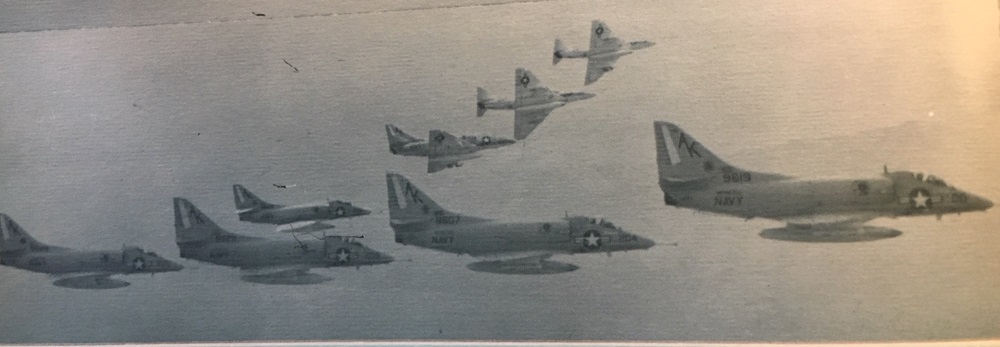 From
the Intrepid 1967 Cruise
Book
|
Transition from A4Bs to A4Cs
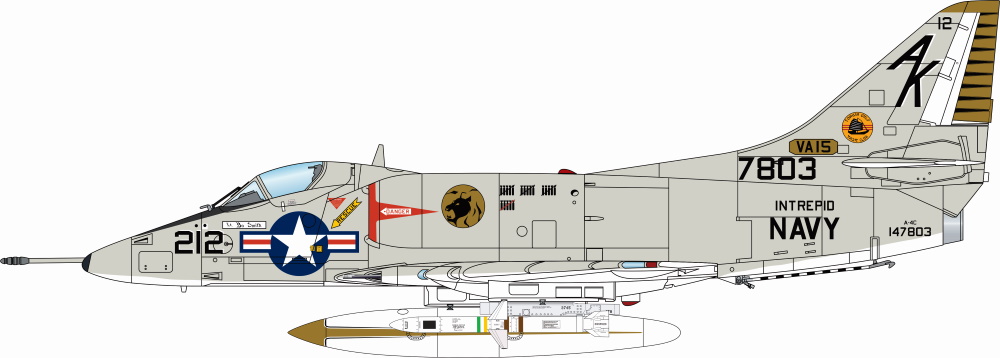 |
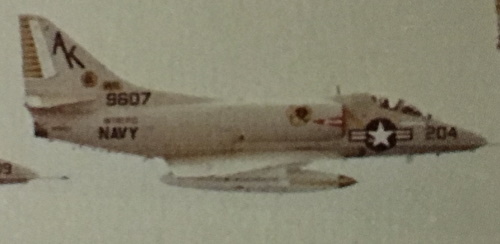 |
In the new CAG 10 squadron mix, we were scheduled to have 200 series aircraft numbers. The 200 series tail number is usually for a fighter and the color is usually yellow. We decided that our version of yellow would be gold and we would paint our aircraft rudders gold with some black. As a result, we were known in the air wing as the "Gold Tails" ! |
 |
Instead of the traditional Valion decal, we designed a Disney-like Lion in black with a gold background. |
Toward
the end of December, we began
transferring our A4Bs and began
receiving A4Cs. In December, I
flew 5 A4C flights and 9 A4B
flights. In January, I flew 8
A4C flights and my last 3
flights in the A4B. The A4Cs
were a significant
upgrade. Instead on the
one black on black ADI (Attitude
Direction Indicator) in the A4B,
our A4Cs had a larger white over
black ADI and a smaller
backup ADI which was black over
black. This made night and
actual instrument flying much
safer.
Our new A4Cs also had the Electronic Counter Measures (ECM) equipment (APR 25/APR 27, ALQ 51) that we would need to accomplish our mission on our next Vietnam deployment. One of our two 20mm guns was removed to accommodate the EW equipment. We were scheduled to be the primary air wing Iron Hand (anti SAM) squadron. To do that mission, we would need the ECM equipment to receive and identify acquisition, search, fire control AAA conical scan radar signals and Fansong SAM radars. We also had the capability to deploy Chaff. Note: Chaff consisted of strips of aluminum foil cut to different lengths to reflect enemy radar signals. Chaff had been around a long time but it had the potential to be effective against the threats we would face in 1967 over North Vietnam.
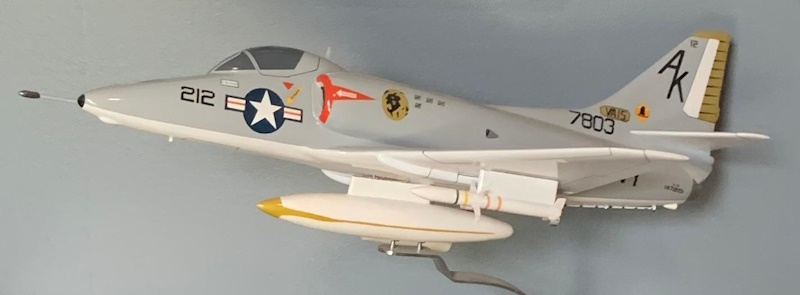 |
Model of
our VA-15 Gold Tail
with a AGM-45 Shrike
missile on the left
wing weapons station
All my flights in January were MK 76 practice bomb delivery flights.
Light Attack Wing Bombing Derby
It was
traditional to have a Light Attack Wing
One annual bombing derby in January. I
don't know if Light Attack Wing One
(LATWING One) was established yet at
Cecil. But, in January 1967, all the
A4 squadrons at Cecil participated in a
bombing derby. There were two pilots at
Cecil that were neck and neck to receive
the "Best Bomber" trophy; both in
VA-15. LCDR Possum Terrell (Rocket
5) and Ltjg Gene Atkinson (Rocket 18, our
junior JO pilot). Possum provided at
difficult challenge with a CEP (closest
error possible or median miss distance) of
an incredible 25ft or so. (The fleet
average was about 100 ft). Ltjg
Atkinson's CEP was zero, zilch- six out of
six Bulls Eyes
.
New Officers in 1967 |
The LATWING One Bombing Derby Best Bomber in January 1967 was Ltjg Gene "Wimpy" Atkinson of VA-15 |
Note: Possum and I would both
win this competition in A7
Corsairs in later years when
Possum was CO of VA-174 and
I would win it in 1978 when I was CO of VA-15. It was different for Possum and me as we were using the A7E inertial Navigation system and heads up display for our bombing! Of course, our respective maintenance folks made sure that we had the most accurate systems in our airplanes.
I would win it in 1978 when I was CO of VA-15. It was different for Possum and me as we were using the A7E inertial Navigation system and heads up display for our bombing! Of course, our respective maintenance folks made sure that we had the most accurate systems in our airplanes.
Job Changes
It is
traditional that in a typical two year
tour in a squadron, a pilot would have
two collateral duty assignments;
one for a year; another for the second
year. January was the best time to
make these changes. I left my
Aircraft Division job working for
Jerry Tuttle and moved upstairs
(literally from an office on the
bottom deck of the hangar where all
the maintenance shops were to the
Operations Department on the second
deck of the hangar where the ready
room and the administrative and
operations offices were located. My
new boss was Pete Schoeffel, the
Operations Officer. My new job was the
Weapons Training Officer (WTO).
The WTO was
responsible for pilot nuclear weapons
and loading training as well as the
conventional weapons delivery misions
in the squadron training plan (flight
schedule). Pete had written a
detailed training plan during the
transit from the Tonkin Gulf back to
Mayport (he was assigned as the senior
CAG 10 representative). So, that part
of my new job was pretty much a done
deal. We did the required number
of nuclear weapons loading exercises
and flew some profile flights. But
that was about it for nuclear weapons
part of my job.
My biggest responsibility was to design the electronic warfare and anti AAA/SAM tactics we would use on cruise and create a training plan to ensure that we would be prepared to execute that mission when we arrived on Yankee Station in June. I would also work with Jerry Tuttle, Bob Chaney and our new Avionics Officer, CWO Pilkington in the Maintenance Department to make sure that our new ECM equipment would be as reliable as possible. It was critical that the pilots flying the bombing and Iron Hand missions have absolute confidence that the ECM equipment would be effective.
Another important job change was Miller Detrick moving from the Line Division to Operations as the Flight Officer. The Flight Officer writes the daily flight schedule which is approved by the Ops Officer and signed by the Commanding Officer. The Flight Officer can be a very political position as every pilot wants at least equal if not more than equal flight time and carrier landings.
My biggest responsibility was to design the electronic warfare and anti AAA/SAM tactics we would use on cruise and create a training plan to ensure that we would be prepared to execute that mission when we arrived on Yankee Station in June. I would also work with Jerry Tuttle, Bob Chaney and our new Avionics Officer, CWO Pilkington in the Maintenance Department to make sure that our new ECM equipment would be as reliable as possible. It was critical that the pilots flying the bombing and Iron Hand missions have absolute confidence that the ECM equipment would be effective.
Another important job change was Miller Detrick moving from the Line Division to Operations as the Flight Officer. The Flight Officer writes the daily flight schedule which is approved by the Ops Officer and signed by the Commanding Officer. The Flight Officer can be a very political position as every pilot wants at least equal if not more than equal flight time and carrier landings.
 Commanding
Officer
|
 Executive
Officer
|
New Heavies
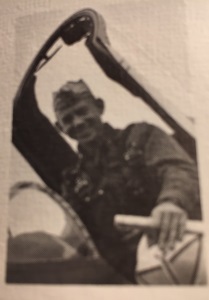 LCDR
Paul McCarthy
|
 LCDR
Ron Gibson
|
New Junior Officers
 Lt
Steve Smith
|
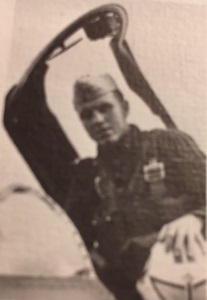 Lt
Tony Isger
|
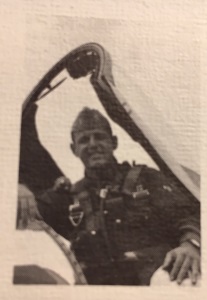 Ltjg
Keith Strickland
|
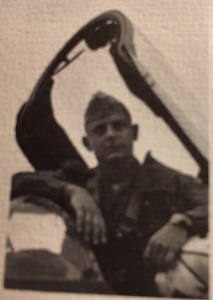 Ltjg
Ron Gerard
|
Note: Steve Smith was new to our squadron but had a previous Vietnam deployment in VA-12 in 1966 aboard the USS Roosevelt (CVA42).
Tony Isger, Keith Strickland, and Ron Gerard all came form the A4 Training Squadron (VA-44); Tony transitioned from S2Fs and Keith transitioned from helicopters.. Ron was a "nugget" (VA-15 was his first squadron) from the training command.
New Ground Officer
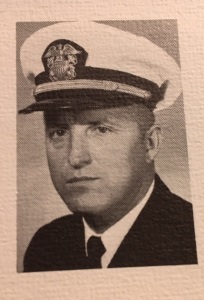 |
| Chief
Warrant Officer Pilkington- Avionics |
All the photo is from the USS Intrepid's 1967 Cruise Book
February 1967
I flew only 12
flights in February. Most of them were
bombing flights both day and night with a
couple of live 6 Mk 81 250# (two TERS)
flights to Pinecastle Target.
I flew one cross country at night from Cecil to Andrews AFB on February 15th returning in the evening the next day, February 16th. I think I spent the day (February 16th) looking at my records at the Bureau of Naval Personnel. I really don't know why I did that but I expect that someone advised me that it was a good idea to check your records on occasion. This was the first of only two days in my entire 28 year navy career that I spent in Washington. I consider that to be a highlight in my career although it might have not been a benefit when my record was reviewed for Flag rank.
In this case, that did not occur. Ron's Skyhawk collided with Jerry Tuttle's aircraft badly damaging both planes. Ron's aircraft was uncontrollable so he ejected shortly after the collision. Jerry Tuttle attempted to get his plane under control but it was a futile effort as most of Jerry' Tuttle's left wing wing was missing. He lost several thousand feet of altitude during his attempt to regain control and ended up ejecting well below Ron. As they were both descending in their parachutes toward Earth, Ron was closing on Jerry Tuttle for the second time. Ron weighed about 200 lbs while Jerry Tuttle was about 150 soaking wet. They nearly collided again as Ron passed Jerry on the way down. Ron looked over and noticed Jerry Tuttle checking his watch. I guess Jerry Tuttle was gathering data for the accident board. Luckily, both were uninjured and were back flying the next day.
I flew one cross country at night from Cecil to Andrews AFB on February 15th returning in the evening the next day, February 16th. I think I spent the day (February 16th) looking at my records at the Bureau of Naval Personnel. I really don't know why I did that but I expect that someone advised me that it was a good idea to check your records on occasion. This was the first of only two days in my entire 28 year navy career that I spent in Washington. I consider that to be a highlight in my career although it might have not been a benefit when my record was reviewed for Flag rank.
Tuttle
versus Gerard (actually visa versa)
I'm not
sure whether this occurred in March,
but it is very likely it did.
Ron Gerard was flying as Jerry
Tuttle's wing man on a flight that
required some formation flying (as
most flights did). Ron Gerard
was executing a rendezvous (a join
up for you air force types).
To rendezvous on another aircraft,
you get inside the turn of the lead
aircraft and while keeping the lead
visually on the horizon and with
some closure speed, the geometry of
the situation will allow you to
close the distance in a controlled
fashion. As you get close to the
other aircraft, you fly your
aircraft a little below the lead's
altitude and as you slide
underneath, you control your excess
airspeed to decrease so you slide in
to the echelon wing position.
In this case, that did not occur. Ron's Skyhawk collided with Jerry Tuttle's aircraft badly damaging both planes. Ron's aircraft was uncontrollable so he ejected shortly after the collision. Jerry Tuttle attempted to get his plane under control but it was a futile effort as most of Jerry' Tuttle's left wing wing was missing. He lost several thousand feet of altitude during his attempt to regain control and ended up ejecting well below Ron. As they were both descending in their parachutes toward Earth, Ron was closing on Jerry Tuttle for the second time. Ron weighed about 200 lbs while Jerry Tuttle was about 150 soaking wet. They nearly collided again as Ron passed Jerry on the way down. Ron looked over and noticed Jerry Tuttle checking his watch. I guess Jerry Tuttle was gathering data for the accident board. Luckily, both were uninjured and were back flying the next day.
It
was time to have another squadron
party and it was a great one!
All of our
new officers had checked in and our
underway training was only weeks away
so it was time to have a
party. I don't remember who came
up with the idea of an auto rally type
scavenger hunt designed to end up at a
barn type dance hall, but it was a
great one! We met somewhere, perhaps
the Cecil BOQ Rocket 17 bar to
pick up the first clue and get
underway with an assigned navigator,
someone other than your wife.
The idea was to drive to the first
check point, pick up the 2nd clue and
drive to the 2nd check point
etc. After a few check points,
you would arrive at the final
destination which was the square
dancing barn. I
think we started at the BOQ about 1930
(7:30 pm). The instructions read that
if you had not arrived at the final
destination (description not given) by
2100 (9:00 pm), you should call a
phone number. There were
numerous couples who got lost??
 The new CO, Cdr Kelly Carr and his wife Pat on the right (new guy Ltjg Ron Gerard on the left |
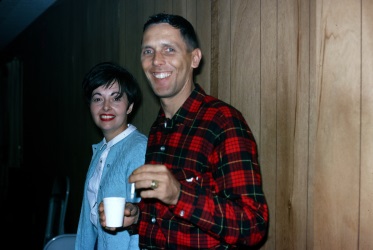 The
new XO, Cdr Jim Snyder and
his wife Joanne
|
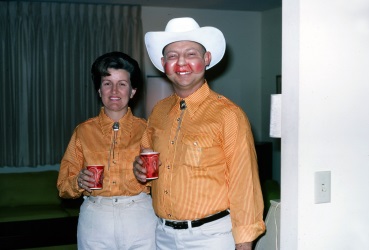 LCDR
Possum Terrell and his wife
Sarah
|
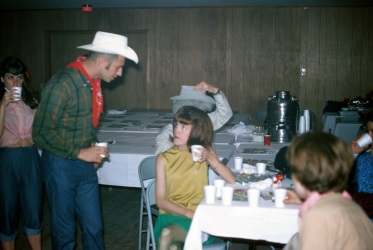 LCDR
Moon Moreau talking to
Miller Detrick's wife Connie
|
 Bob
Hamel and his wife Lynn
|
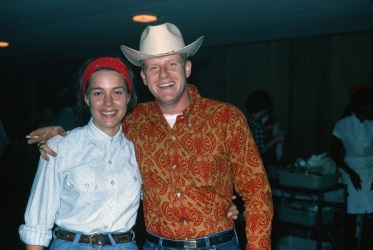 John
Newman and his first wife
|
 Group
square dance; that's Dick Nolte
dancing with someone's wife
|
 New guy
Ltjg Keith Strickland and his wife
Marce
|
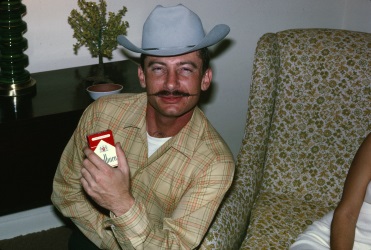 New guy
Ltjg Steve Smith
|
March 1967
The first part
of March was devoted primarily to getting
ready for our first underway type training
period on board Intrepid in the middle of
the month. We flew some weapons
flights but most flights involved doing
day and night field carrier landing
practice (FCLP) at nearby NAAF (Navy
Auxiliary Air Field) Whitehouse.
In those days, some air wings were located at Cecil. That was the case with Airwing Ten. The CAG 10 LSO, LCDR Fred Hoerner who still flew mostly with VA-15 was present for most of the FCLP sessions at Whitehouse. The CAG 10 squadrons based on the east coast were VAW 121s E1B Trackers based at NAS Nofolk, VAQ 33 Det 11s AD5Qs at NAS Jacksonville, and VA-15 and our "sister" A4C squadron VA-34 at Cecil. I don't know how CAG 10 handled the FCLPs for the west coast squadrons (VSF-3 A4Cs, VA-145 Spads based at NAS Alameda, VF-111 Det 11s F8Cs and VFP-63 Det 11's RF-8s based at NAS Miramar). COMVAVAIRPAC (Commander Naval Air Pacific) probably assisted with those squadrons. The primary emphasis for us and VA-34 was to make sure the new guys were ready. The rest of us only had about one day FCLP session at Cecil and three night FCLP sessions at Whitehouse Field.
I actually had one very close call during one of my night FCLP flights to Whitehouse. The outside air temperature was close to the dew point so there was a good chance that fog would form. The normal procedure was that Cecil would keep the LSOs at Whithouse up to speed with the dew point spread so that if it got close, they would send the aircraft back to Cecil before the field became "socked in" (weather too bad to land). I happened to be on deck at Whitehouse getting some fuel when the decision to return to Cecil was made. In my rush to get airborne, I didn't do my check list thoroughly and I made my take off roll with my flaps up. When I got to rotation speed for take off, nothing happened. Luckily, I determined that my flaps were up (by the feel of the aircraft not the flap guage), and lowered my flaps (to 1/2) in time to get airborne before the end of the runway. Close call. I've never told this story before!.
Our first underway training period only lasted 10 days from March 15th through March 25th. I flew only 7 flights during our first underway period. Most of those flights concentrated on practicing the CAG 10 and Intrepid daytime VFR operating procedures. I logged only .3 night hours with two "pinky" night landings during the first underway period. "Pinky" landings are twilight landings which are technically after sunset but with still a visible horizon available. The west coast squadrons stayed on the west coast for the first underway period because their deployment actually started once they moved to the east coast.
Our second underway training was from April 17th through April 25th. I think the west coast squadrons may have come east for that one to get some flying with the rest of the air wing before we deployed on May 10th.
I flew 12 flights during that period. I recorded my 200th landing (trap) on the Intrepid on April 17th. One of my flights was a AGM 45 Shrike training mission. We had "captive" Shrikes on board for these training missions.
We would have only 13 days before we would fly to Norfolk to load our aircraft on board Intrepid for deployment; not enough time for a quick trip to the Bahamas this time around. We used the time to get our stuff together with our families for the seven month deployment.
Mary, Heather, and Laura would spend some of that time with Mary's family in Duxbury!
Note: USS Intrepid was officially a CVS during our deployment; although we didn't have any aircraft assets to find or attack a submarine. Our deck load was designed to provide the maximum power projection punch we could; hence three A4C Skyhawk squadrons versus the two A4E squadrons embarked on in the other Yankee Station carriers. Please pardon my inconsistency in referring to Intrepid as a CVA or CV. I'll make those corrections when I can.
The new CAG 10 / USS
Intrepid squadrons for the second
deploymentIn those days, some air wings were located at Cecil. That was the case with Airwing Ten. The CAG 10 LSO, LCDR Fred Hoerner who still flew mostly with VA-15 was present for most of the FCLP sessions at Whitehouse. The CAG 10 squadrons based on the east coast were VAW 121s E1B Trackers based at NAS Nofolk, VAQ 33 Det 11s AD5Qs at NAS Jacksonville, and VA-15 and our "sister" A4C squadron VA-34 at Cecil. I don't know how CAG 10 handled the FCLPs for the west coast squadrons (VSF-3 A4Cs, VA-145 Spads based at NAS Alameda, VF-111 Det 11s F8Cs and VFP-63 Det 11's RF-8s based at NAS Miramar). COMVAVAIRPAC (Commander Naval Air Pacific) probably assisted with those squadrons. The primary emphasis for us and VA-34 was to make sure the new guys were ready. The rest of us only had about one day FCLP session at Cecil and three night FCLP sessions at Whitehouse Field.
I actually had one very close call during one of my night FCLP flights to Whitehouse. The outside air temperature was close to the dew point so there was a good chance that fog would form. The normal procedure was that Cecil would keep the LSOs at Whithouse up to speed with the dew point spread so that if it got close, they would send the aircraft back to Cecil before the field became "socked in" (weather too bad to land). I happened to be on deck at Whitehouse getting some fuel when the decision to return to Cecil was made. In my rush to get airborne, I didn't do my check list thoroughly and I made my take off roll with my flaps up. When I got to rotation speed for take off, nothing happened. Luckily, I determined that my flaps were up (by the feel of the aircraft not the flap guage), and lowered my flaps (to 1/2) in time to get airborne before the end of the runway. Close call. I've never told this story before!.
Our First
Underway Training Period
Our first underway training period only lasted 10 days from March 15th through March 25th. I flew only 7 flights during our first underway period. Most of those flights concentrated on practicing the CAG 10 and Intrepid daytime VFR operating procedures. I logged only .3 night hours with two "pinky" night landings during the first underway period. "Pinky" landings are twilight landings which are technically after sunset but with still a visible horizon available. The west coast squadrons stayed on the west coast for the first underway period because their deployment actually started once they moved to the east coast.
April 1967
My AGM-45 Shrike ARM (Anti-Radiation Missile) and Practice Firing at NAF China Lake and NAS Point Magu, California Trip
My AGM-45 Shrike ARM (Anti-Radiation Missile) and Practice Firing at NAF China Lake and NAS Point Magu, California Trip
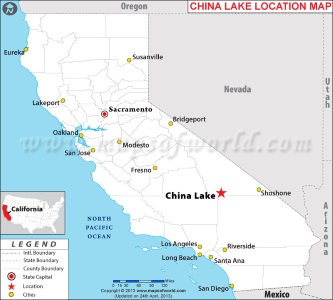 |
 |
On April
9th I flew A4C #147670 to China Lake
with a fuel stop at Shepherd Air Force
Base in Wichita Falls, Texas. For the
next two days (April 10th and 11th), I
received training in basic electronic
warfare from personnel (especially the
EW "guru" Jud Smith; see Note below)
at the Naval Air Weapons Station at
China Lake. I learned how to use our
A4C electronic warfare equipment to
identify acquisition radars (low PRF
low scan rate), AAA "conical scan"
acquisition and tracking high PRF
(Pulse Repetition Frequency), S Band
conical scan radars such as
Firecan/Flapwheel systems, and the
Fansong E Band SAM control radar with
its distinctive raster scan. I
was provided with a set of tapes to
use for training our pilots to be able
to identify these types of radars in
the North Vietnam defense system. On
April 12th, I flew to NAS Point Magu,
California to be briefed on the AGM-45
Shrike missile at the Naval Missile
Development Center there. We
also went over the procedures we would
use for my scheduled test firing of a
Shrike the next day at the China Lake
Electronic Warfare range.
 |
 AGM-45
Shrike missile
|
Note; It
turned out that Jud Smith was an
amateur Geologist and knew a lot about
the history of placer god mining and
silver mining in the mountains in the
background of the image below. I was
interested in learning more (my BA
degree from Cornell was a BA in
Geology). Jud Smih nd I managed to
find some time for an afternoon field
trip.
The next day (April 14th), I flew A4C #147670 back from China Lake to Cecil with one fuel stop (This flight is not in my log book for some reason). This trip to China Lake and Pt. Magu for electronic warfare training and the Shrike firing test were essential for me to be able conduct the training for our squadron pilots in the electronic warfare skills; especially essential for Iron Hand pilots.
During our transit from Norfolk to the Tonkin Gulf, I conducted the EW training of the squadron pilots that we would need as Iron Hand and as bomber pilots to recognize the EW environment we would be flying in. Each pilot would spend hours studying the tapes I got at China Lake. We would also develop the Iron Hand tactics we tactics we would successfully use as the air wing Iron Hand "experts"during our deployment. I will describe these tactics in detail later on in this chapter.
Our
Second
Underway Training Period |
On the morning of April 13th, I took off from NAS Pt. Magu and flew back to China Lake. After landing, a Shrike missile was loaded on my aircraft and I took off and made eight simulated firing runs against a conical scan fire control radar similar to the Russian built Firecan/Flapwheel AAA radars. After I landed from that flight, we conducted a briefing for my Shrike firing test on the range. My AGM 45 Shrike scored a direct hit on the target. |
 |
The next day (April 14th), I flew A4C #147670 back from China Lake to Cecil with one fuel stop (This flight is not in my log book for some reason). This trip to China Lake and Pt. Magu for electronic warfare training and the Shrike firing test were essential for me to be able conduct the training for our squadron pilots in the electronic warfare skills; especially essential for Iron Hand pilots.
During our transit from Norfolk to the Tonkin Gulf, I conducted the EW training of the squadron pilots that we would need as Iron Hand and as bomber pilots to recognize the EW environment we would be flying in. Each pilot would spend hours studying the tapes I got at China Lake. We would also develop the Iron Hand tactics we tactics we would successfully use as the air wing Iron Hand "experts"during our deployment. I will describe these tactics in detail later on in this chapter.
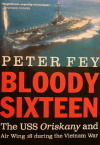 |
On pages 227 and 228 of his book "Bloody Sixteen, Peter Fey expounds on the expertise of Lt Dave "Rock" Hodges of VA-164 as the CAG Sixteen Iron Hand expert. His description of Rock Hodges' talents accurately describes the knowledge and tactics hopefully used by anyone who had had the China Lake Shrike and EW training at China Lake. I would hope that the Navy routinely sent any pilot who would be in charge of Iron Hand mission planning to this training. |
Our second underway training was from April 17th through April 25th. I think the west coast squadrons may have come east for that one to get some flying with the rest of the air wing before we deployed on May 10th.
I flew 12 flights during that period. I recorded my 200th landing (trap) on the Intrepid on April 17th. One of my flights was a AGM 45 Shrike training mission. We had "captive" Shrikes on board for these training missions.
An Interesting
Night Flight
I was flying a night flight with the XO, CDR Snyder. It was about 0100 (1:00am) when we were about to return to the area of the ship called Marshal to set up a holding pattern at individual altitudes to initiate our instrument approach to the ship. It was on his wing, when he appeared to accelerate ahead of me. It was too early for us to split up so I added power to catch up. Even at full throttle (power), I couldn't catch up with him so I gave up and turned toward Marshall on my own.
I was heading toward the ship observing how spectacular the stars were. To add to the magic, St. Elmo's Fire (you can Goggle it) was flickering around my canopy when I heard a voice in my head:
"
Isn't this a beautiful universe I
created"
I was flying a night flight with the XO, CDR Snyder. It was about 0100 (1:00am) when we were about to return to the area of the ship called Marshal to set up a holding pattern at individual altitudes to initiate our instrument approach to the ship. It was on his wing, when he appeared to accelerate ahead of me. It was too early for us to split up so I added power to catch up. Even at full throttle (power), I couldn't catch up with him so I gave up and turned toward Marshall on my own.
I was heading toward the ship observing how spectacular the stars were. To add to the magic, St. Elmo's Fire (you can Goggle it) was flickering around my canopy when I heard a voice in my head:
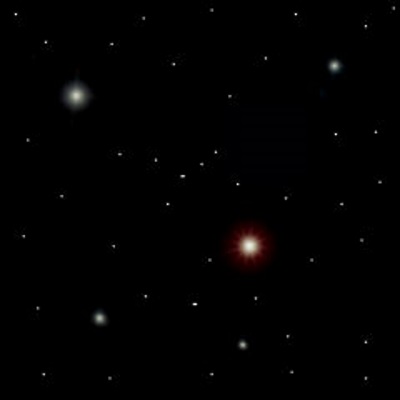 |
 |
After the
LSO debriefed our passes in the ready
room, I asked CDR Snyder why he
accelerated ahead of me. He replied,
"I didn't accelerate, all of a sudden
you just accelerated ahead of me" so I
went to Marshall. After we discussed
it a bit more, we decided that I had
experienced autokinesis.
Autokinesis occurs at night if you
stare at a single point of light ((a
star or planet) for long enough, it
will appear to move. It turns out that
I tried to fly wing on a star.
We flew off
from the boat (naval aviators refer to the
carrier as the boat rather than the
ship) on April 25th.We would have only 13 days before we would fly to Norfolk to load our aircraft on board Intrepid for deployment; not enough time for a quick trip to the Bahamas this time around. We used the time to get our stuff together with our families for the seven month deployment.
Mary, Heather, and Laura would spend some of that time with Mary's family in Duxbury!
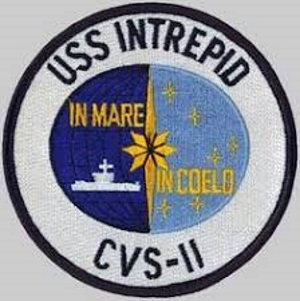 |
Our
Second Deployment
|
Note: USS Intrepid was officially a CVS during our deployment; although we didn't have any aircraft assets to find or attack a submarine. Our deck load was designed to provide the maximum power projection punch we could; hence three A4C Skyhawk squadrons versus the two A4E squadrons embarked on in the other Yankee Station carriers. Please pardon my inconsistency in referring to Intrepid as a CVA or CV. I'll make those corrections when I can.
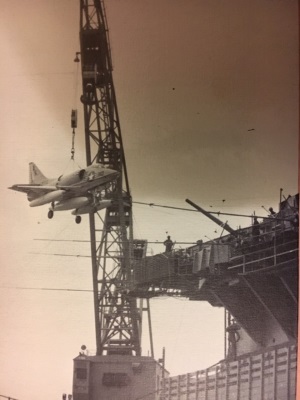 Photo
from Intrepid's 1967 Cruise
Book
|
Instead of flying our aircraft on board Intrepid after they got underway, we flew our aircraft from Cecil Field to NAS Norfolk on May 9th to be loaded aboard the ship. After all the air wing aircraft were loaded on board, the ship got underway for our 31 day12,000 mile transit to Cubi Point in the Philippines. Intrepid left Norfolk May 11th, 1967 |
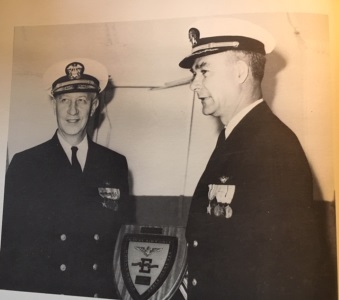 Photo from
Intrepid's 1967 Cruise
Book
|
Shortly after getting on board, we learned that the Intrepid had been awarded the CONAVAIRLANT Battle Efficiency Award for our 1966 deployment. VA-15 had been awarded a Meritorious Unit Citation for our participation in our first Vietnam deployment. |
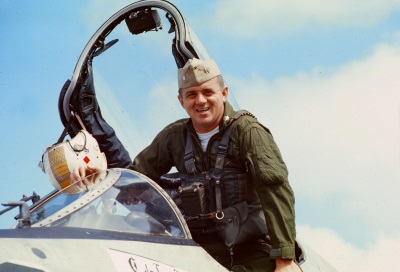 CAG
Burrows "Eatrthquake" and
his staff brought their
experience from the first
cruise with them for the
second deployment
|
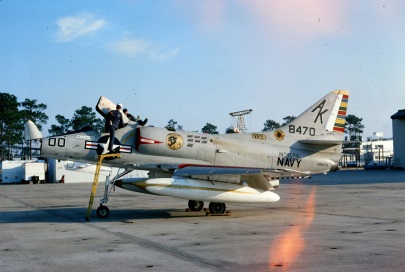 CAG's
plane with the gold tail
cap, rainbow rudder, our
VA-15 "Gold Tails" logo
and fancy fuel tanks
|
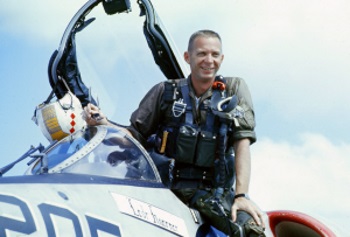 |
LCDR Fred Hoerner CAG 10 LSO flew regularly with VA-15 as he did last cruise. His name was temporarily added to aircraft 205 (Possum's aircraft) shown here. The CAG 10 Operations Officer, Ed Gilreath, flew with VA-34 "Brand X"! |
As
we were scheduled to fly most of
our missions from Yankee Station
on this deployment, there was a
significant change in our air wing
squadrons. This time we had three
A4 squadrons instead of two and
only one Spad squadron. The Spad
squadron would primarily fly
RESCAP missions. To provide
some fighter capability, we would
have a detachment of four F8C
Crusader aircraft for the TARCAP
mission. We would also have
a detachment of three RF8
Crusaders to provide a photo
reconnaissance capability.
In addition, we would have a
detachment of AD5Q Spad electronic
warfare support aircraft (Queer
Spads) and a detachment of E1B
airborne early warning aircraft to
provide coordination with the
Yankee Station Air Defense ship
(PIRAZ), and BARCAP aircraft in
support to our TARCAP F8s.
The ship would have a SAR helo detachment and a Carrier Onboard Delivery (COD) aircraft.
The ship would have a SAR helo detachment and a Carrier Onboard Delivery (COD) aircraft.
The Fighter
Mission
The Sundowners of VF-111
Det 11 had four F8C
Crusader aircraft for
the TARCAP mission. Lcdr
Foster "Tooter" Teague was
part of the VF-111 Sundowners
of CAG 16 on the Oriskany on
their summer 1966 deployment.
Having
returned to the states after
the Oriskany fire in October,
"Tooter had a quick turnaround
as our fighter detachment OIC
(Officer in Charge) on
Intrepid.
 |
On pages 144 and
145 his book "Bloody
Sixteen, Peter Fey describes
an exciting flight "Tooter"
had flying escort for a RF8
mission over Haiphong. The Sundowners flew a lot of TARCAP during 1966 as as the Coral Sea had F4 Phantoms for the BARCAP/MIGCAP MISSIONS. Fey also mentioned that "Tooter" was well known among pilots in CAG 16 for his antics on liberty. |
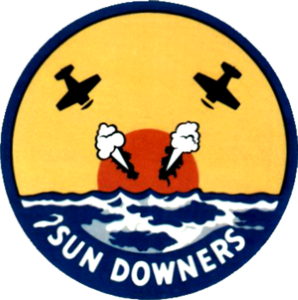 |
 |
A
significant addition to our
capability for this deployment
were the Sundowners of VF-111 Det
11 of four F8C Crusader aircraft
for the TARCAP mission. They
were home based at NAS
Miramar, California. They
had three infamous pilots; the
Detachment Officer in Charge, LCDR
"Tooter" Teague, Lt Tony Nargi,
and Lt Joe Satrapa and one not so
infamous pilot, Ltjg Rick Wenzel.
Four pilots, four aircraft; so they each had their name on an F8. These guys were the best the fighter community could have given us with the best aircraft for the TARCAP mission. They stayed with the strike group and were not drawn away by PIRAZ (Air Defence Coordination Ship) or by the temptation to leave us in a search for a MIG kill. One of them, "Tooter"was shot down on August 12th by AAA or a SAM during our second line period but was rescued.
The VSF -3 (Aintisubmarine Fighter Squadron) Chessmen were home based at NAS Alameda, California and flew the A4C Skyhawk. VSF squadrons were created to fly the fighter mission on ASW (Antisubmarine Aircraft Carriers (CVS).
They were added to our air wing to primarily fly as bomber aircraft in major strikes and to conduct road reconnaissance flights and section and division level strikes on targets close to the coast.
They flew A4C aircraft configured like ours with updated electronic countermeasures equipment. Project Shoehorn installed the APR- 25 and the ALQ51 by removing the left 20mm gun and most of the ammunition to make room to install the ECM gear. The disadvantage of this was that only 75 rounds of 20mm for the right gun was left to use only in emergency like in a downed pilot RESCAP mission or in self defense if attacked by a MIG.
VSF 3s A4Cs had side numbers of the 100 series so had the red color as the color on their tail cap.
VA-15 had the 200 series numbers so we were supposed to have a yellow tail color. We chose to change that to gold so we had our rudder painted gold and black and replaced the VALion decal with a gold and black lion logo. We were known in the air wing as the "Gold Tails"
The aircraft in this picture is configured for our Anti SAM Iron Hand mission with the AGM 45 Shrike loaded on both wings with a center line fuel tank. If we had a shortage of Shrike missiles, we flew with one AGM-45 Shrike on one wing and a LAU 10 5" Zuni rocket pod on the other wing.
 |
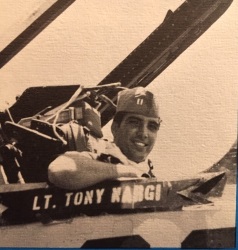 |
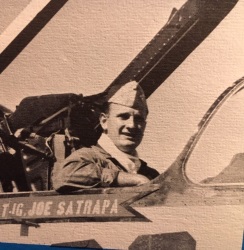 |
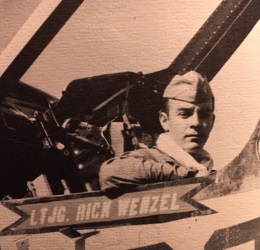 |
Four pilots, four aircraft; so they each had their name on an F8. These guys were the best the fighter community could have given us with the best aircraft for the TARCAP mission. They stayed with the strike group and were not drawn away by PIRAZ (Air Defence Coordination Ship) or by the temptation to leave us in a search for a MIG kill. One of them, "Tooter"was shot down on August 12th by AAA or a SAM during our second line period but was rescued.
The Attack
Mission
We had three light attack A4C Skyhawk squadrons
We had three light attack A4C Skyhawk squadrons
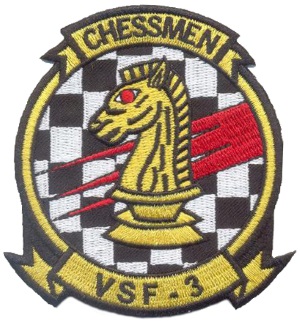 |
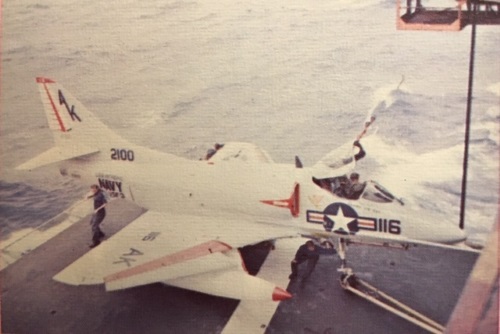 |
The VSF -3 (Aintisubmarine Fighter Squadron) Chessmen were home based at NAS Alameda, California and flew the A4C Skyhawk. VSF squadrons were created to fly the fighter mission on ASW (Antisubmarine Aircraft Carriers (CVS).
They were added to our air wing to primarily fly as bomber aircraft in major strikes and to conduct road reconnaissance flights and section and division level strikes on targets close to the coast.
They flew A4C aircraft configured like ours with updated electronic countermeasures equipment. Project Shoehorn installed the APR- 25 and the ALQ51 by removing the left 20mm gun and most of the ammunition to make room to install the ECM gear. The disadvantage of this was that only 75 rounds of 20mm for the right gun was left to use only in emergency like in a downed pilot RESCAP mission or in self defense if attacked by a MIG.
VSF 3s A4Cs had side numbers of the 100 series so had the red color as the color on their tail cap.
 |
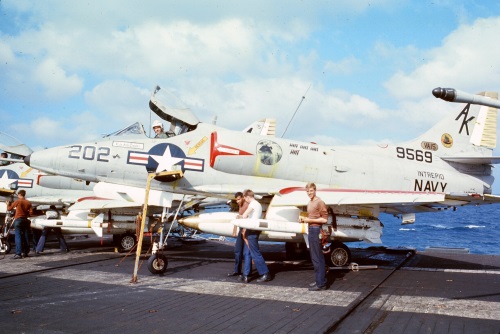 |
VA-15 had the 200 series numbers so we were supposed to have a yellow tail color. We chose to change that to gold so we had our rudder painted gold and black and replaced the VALion decal with a gold and black lion logo. We were known in the air wing as the "Gold Tails"
The aircraft in this picture is configured for our Anti SAM Iron Hand mission with the AGM 45 Shrike loaded on both wings with a center line fuel tank. If we had a shortage of Shrike missiles, we flew with one AGM-45 Shrike on one wing and a LAU 10 5" Zuni rocket pod on the other wing.
 |
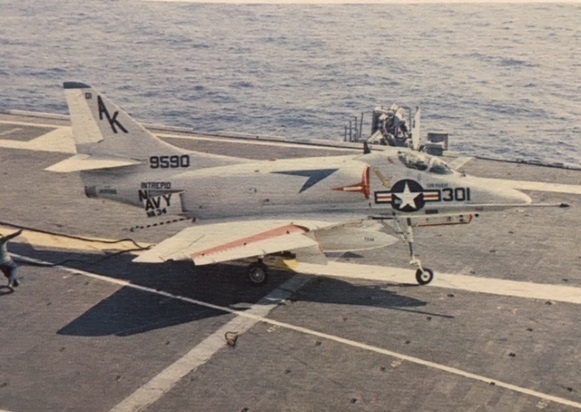 |
The
third
Skyhawk squadron in the air
wing was our sister squadron
stationed at Cecil Field, the
VA-34 Blue Blasters.
They flew A4C
aircraft configured like ours
with updated electronic
countermeasures equipment.
They had 300 series numbers
abnd a blue tail cap.
In addition to participating in bombing missions, their assigned specialty was as flak suppressors, the anti AAA mission. They would attack known AAA sites in the target area just before the bombers initiated their attacks with the hope that it would offer some protection for the bombers while in their bomb runs which was the most vulnerable part of their mission. They were usually configured with two LAU 10 Zuni rocket pods on TERs on each wing for total of 16 "5 inch" rockets to attack the AAA sites.
In addition to participating in bombing missions, their assigned specialty was as flak suppressors, the anti AAA mission. They would attack known AAA sites in the target area just before the bombers initiated their attacks with the hope that it would offer some protection for the bombers while in their bomb runs which was the most vulnerable part of their mission. They were usually configured with two LAU 10 Zuni rocket pods on TERs on each wing for total of 16 "5 inch" rockets to attack the AAA sites.
The
RESCAP Mission
We
had one A1 Skyraider
(Spad) squadron, VA 145
based at NAS Alameda
 |
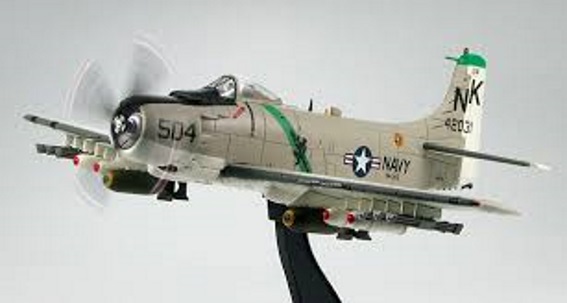 This is a
model of a VA 145
Spad. Ours had
had 400 numbers.
|
VA
145 was based at NAS Alameda,
California. Spads were capable
of carrying an impressive load
of bombs, rockets and guns.
Our Spad squadron during on
our 1966 Dixie Station
line periods were the
aircraft of choice due to
their weapons load and ability
to stay on station for much
longer than jet powered
aircraft. However they were
too vulnerable to SAM and AAA
in the north due to their slow
speed and were limited during
our 1967 deployment to the
RESCAP mission where they
carried forward firing weapons
such as rockets and
guns. They assisted in
14 navy and air force pilot
rescues during our deployment.
 Two VA
145 Spads
returning to the
ship with a VAW--121
E1B. It looks
like the ship is
getting ready to
launch a regular
cycle with the COD
on CAT 1 with A4s on
the port angle, the
relief E1B on the
port aft corner,
three VA-145 RESCAP
aircraft on
the starboard
side of the
landing area,
and a VAQ-33 AD5Q EW
Spad and a
fourth VA-145 Spad
aft of the island.
|
The Photo
Reconnaissance Mission
VFP 63 Det 11 RF8 Crusaders
VFP 63 Det 11 RF8 Crusaders
 |
The VFP 63 Det 11 Roadrunners based at NAS Miramar, California provided a photo reconnaissance capability with their RF8 Crusaders. They were normally escorted by a section of our VF 111 Sundowner F8Cs on their missions. |
 A VFP-63
Det 11 RF8 (402)
|
The Airborne
Electronic Warfare Mission
 |
The VAQ 33 Nighthawks based at NAS Jacksonville, Florida provided an airborne electronic warfare capability with their AD5Q Spad aircraft. |
The Airborne
Early Warning and Command and Control
Mission
"The Angel" HC-2 Rescue Helo Detachment
The Intrepid's COD (Carrier Onboard Delivery) Aircraft
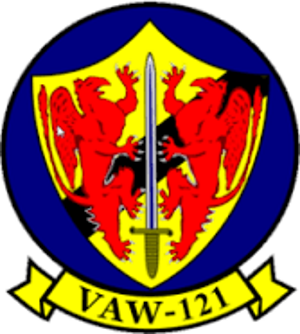 |
The VAW 121 Bluetails based at NAS Norfolk, Virginia provided an airborne early warning and command and control capability with their E1B aircraft. |
"The Angel" HC-2 Rescue Helo Detachment
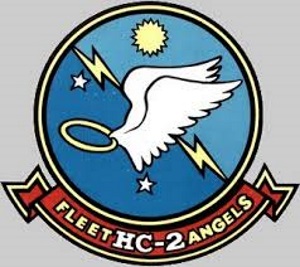 |
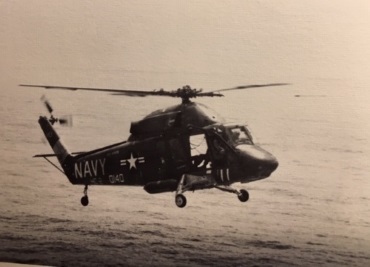 |
The Intrepid's COD (Carrier Onboard Delivery) Aircraft
 |
 |
Our transit of
the Atlantic Ocean and Mediterranean
Sea enroute to the Suez Canal
Replenishment at Sea
We spent lots of time in the Ready Room during the transit
We had many AOMs (All Officer's Meetings) and a lot of briefings in the ready room during the transit.
Some of us who were interested had the opportunity to stand bridge watches during the transit.
The transit also provided lots of opportunity to spend time on the flight deck exercising or just relaxing.
We did some flying during the Mediterranean Sea part of the transit
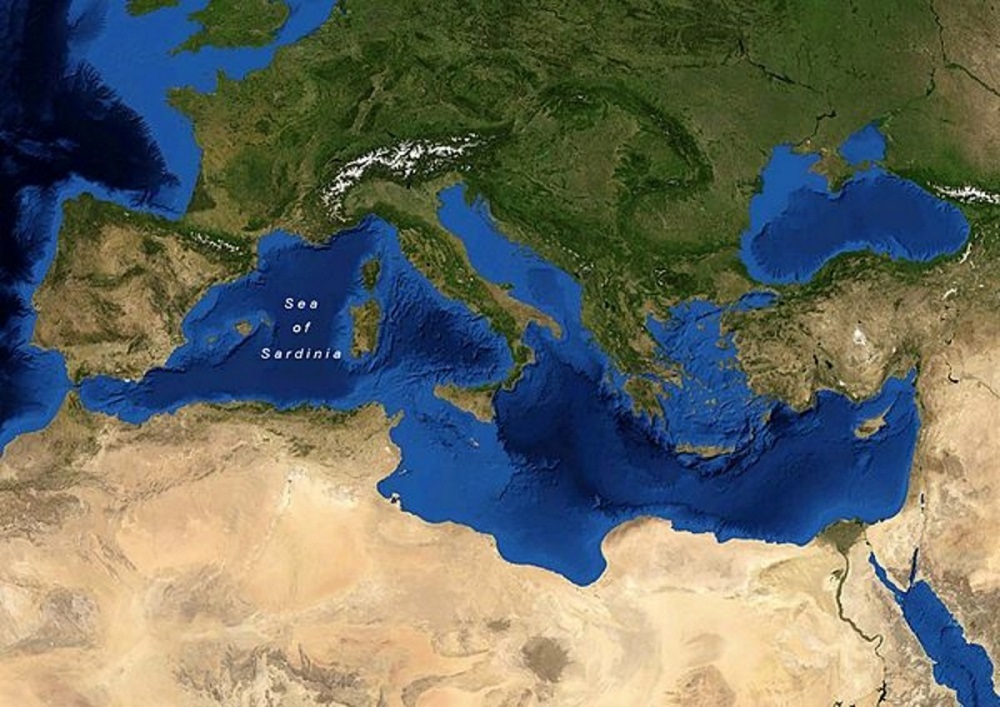
Replenishment at Sea
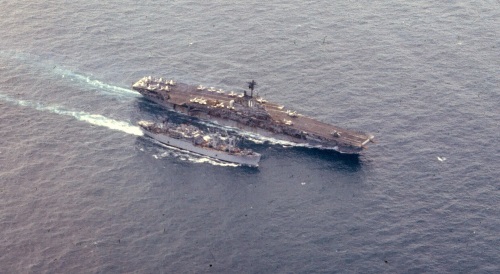 |
We didn't make any port visits during our 38 day 12,000 mile transit from Norfolk to Cubi Point. Intrepid and all the ships in our group got all our fuel and supplies by replenishing at sea like shown in the photo here. The ship made a few COD flights enroute to get our mail. We didn't have to get any weapons during the transit. But once online at Yankee Station, we were along side an AO every few days resupplying bombs, rockets, missiles, and gun ammo. |
We spent lots of time in the Ready Room during the transit
We had many AOMs (All Officer's Meetings) and a lot of briefings in the ready room during the transit.
 Take
note that during
this AOM, the only
officers paying
attention were new
guys Ron Gibson in
the front row and
Dave Moyer in the
back row. Shep was
reading a magazine,
Bob Cheyne was
asleep and Bob Hamel
was being Bob Hamel.
|
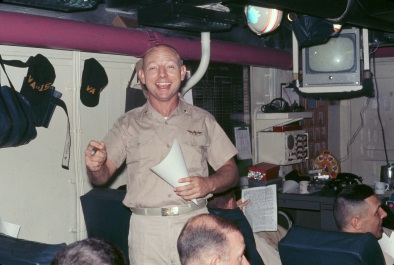 We could smoke our cigars in the ready room in those days! |
We
spent lots of time in our staterooms
getting ready for our Iron
Hand missions by studying the
tapes of acquisition radars such as low
frequency and low scan rate Spoonrest
and Barlock, higher frequency "S Band"
AAA conical scanradars in search and
lock on modes such as Firecan and
Flapwheel, and the "E Band" Fansong SAM
radar with it's characteristic "raster
scan" pattern.
Some of us who were interested had the opportunity to stand bridge watches during the transit.
The transit also provided lots of opportunity to spend time on the flight deck exercising or just relaxing.
 Miller Detrick on the flight deck with his deployment mustache wearing one of the variations of flight suits we used; a green medium cotton shirt and pants with a belt. |
 Left to
right: Dick Nolte,
John Newman, me, Dave
Parsons, Bob Hamel,
Bob Cole, Miller
Detrick. The transit
provided plenty of
opportunities for JO
meetings on the flight
deck before the
evening movie.
|
We did some flying during the Mediterranean Sea part of the transit

I
flew seven flights from May
20th through May 29th; 5 day
flights and 2 flights with
night landings. We were in
range of a bingo field,
probably NAS Sigonella on the
southern coast of Sicily
during these flights.
When we were approaching the Suez Canal, it was June, 1967 and Israel and Egypt were about to get involved in the Seven Day War. So, I'm sure there was a lot of political concern about our transiting the Suez at that time. But for whatever reason, the decision was made at the highest levels and possibly with consultation with both Israel and Egypt for us to make the transit. As all of the jet aircraft were moved to the hangar deck and the hangar bay doors were closed. There was some concern that a weirdo Egyptian extremist might take a few shots at the ship as it passed by. The prop aircraft were left exposed on the flight deck (I guess they were more expendable). We were told to not go on up on the flight deck or exposed catwalks as there was some concern that it was possible that we might take some fire from the Egyptian side. I don't think that we did.
When we were approaching the Suez Canal, it was June, 1967 and Israel and Egypt were about to get involved in the Seven Day War. So, I'm sure there was a lot of political concern about our transiting the Suez at that time. But for whatever reason, the decision was made at the highest levels and possibly with consultation with both Israel and Egypt for us to make the transit. As all of the jet aircraft were moved to the hangar deck and the hangar bay doors were closed. There was some concern that a weirdo Egyptian extremist might take a few shots at the ship as it passed by. The prop aircraft were left exposed on the flight deck (I guess they were more expendable). We were told to not go on up on the flight deck or exposed catwalks as there was some concern that it was possible that we might take some fire from the Egyptian side. I don't think that we did.
 |
This is a modern map of the Suez Canal. In June of 1967, the Sinai Peninsula was part of Israel. So, as we sailed south from Port Said, we had Israel on the left and Egypt on the right. We did encounter protests on the Egyptian side of the canal where the protesters took off their sandals and held the soles of their shoes toward us; a mark of disrespect. We were led through the southern part of the canalfrom the Great Bitter Lake by an Egyptian (Russian Made) Komar PT boat with it's two Styx surface to surface missiles clearly visible. They didn't train the missiles toward Intrepid. They couldn't as the Styx missile tubes are permanently mounted facing forward on the boat. I doubt if they had any fire control radars active. |
 Picture
from the Intrepid 1967
Cruise Book
|
This
is a Komar Boat.
Notice that the
Styx missile tubes
are facing
forward!
|
As we were headed
south from Great Bitter Lake toward
the Indian Ocean, charts of Egypt were
pulled out in CVIC to look at
potential targets in Egypt if were
called into action.
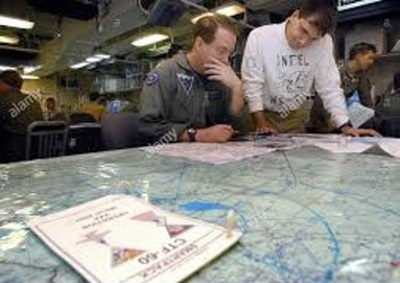

But, after a brief pause in the gulf
of Suez, we continued our transit through
the Indian Ocean, through the Straits of
Malacca, and then northeast to Cubi Point in the Philippines.
 |
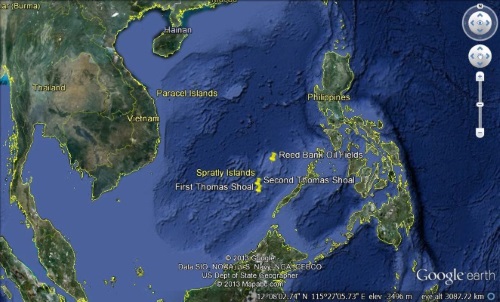 |
Intrepid arrived
in Cubi Point
June 15th, 1967
(The transit from Norfolk to Cubi took 31 days to complete)
Back at Cubi Point only seven months after we left after the end of our first WESTPAC deployment.
We wouldn't have much time here though; just a couple of nights at the BOQ and a few visits to the Cubi Point O'Club bar for some Cubi Specials!
(The transit from Norfolk to Cubi took 31 days to complete)
 |
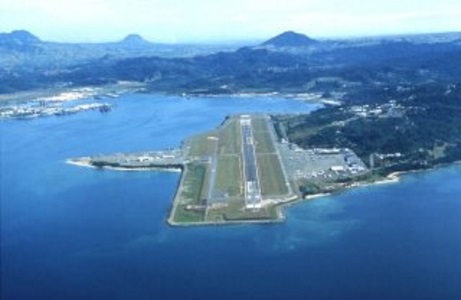 |
Back at Cubi Point only seven months after we left after the end of our first WESTPAC deployment.
We wouldn't have much time here though; just a couple of nights at the BOQ and a few visits to the Cubi Point O'Club bar for some Cubi Specials!
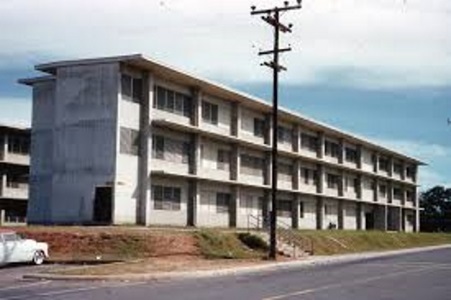 Cubi Point BOQ
|
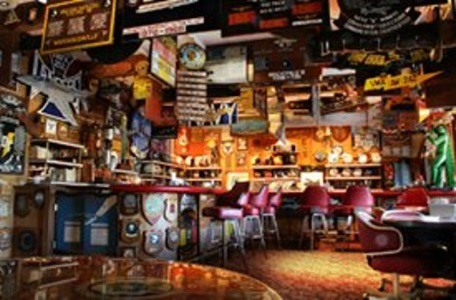 Cubi Point O'Club
|
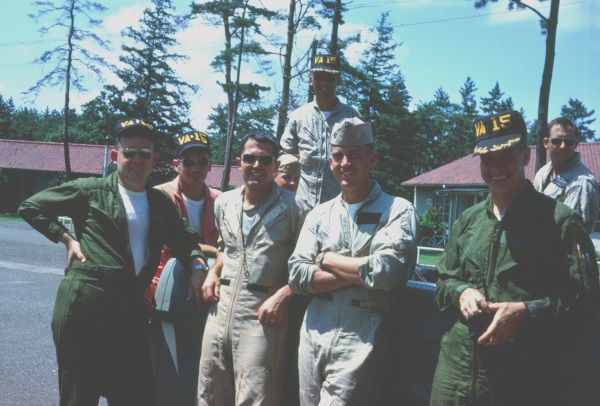 A group of
combat bound VALions in various
type of flight suits relaxing
outside officer's housing at Cubi.
|
| Left to right:
Gene Atkinson, Moon Moreau, Miller
Detrick, the head of Ron Gerard over
Miller's left shoulder, XO, Cdr Jim
Snyder, Dave Parsons, CO, CDR Kelly
Carr, and me, Bo Smith over Cdr
Carr's left shoulder (I'm sure Moon didn't wear that orange flight suit on combat missions!) |
Or possibly,
a chance to have dinner at the Marmont
Hotel in Olongapo!
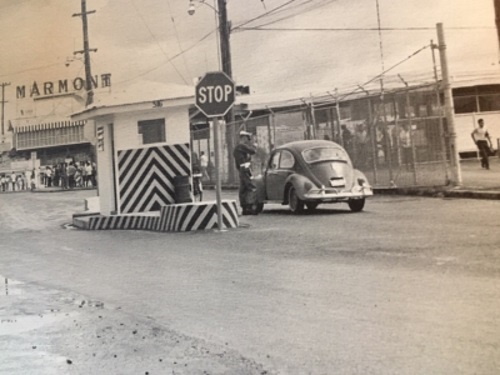 |
|
| Maybe
just enough time for a quick trip
outside the gate in Olongapo to have
dinner at the Marmont Hotel. |
The
Marmont Hotel was convenient, just
outside the gate, and had excellent
food. |
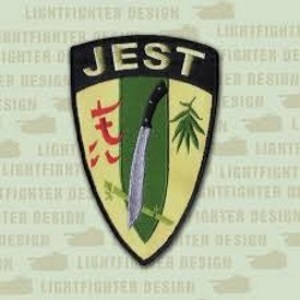 |
The new guys might have had a quickie course in Jungle Escape and Survival Training (JEST)! |
USS Intrepid left Cubi Point on June 19th after only four days in port.
We flew on the ship that day!
Yankee Station
We arrived on Yankee Station On June 21st during Operation Rolling Thunder 57.
The summer
of 1967 consisted of the heaviest
bombing of North Vietnam during
Operation Rolling Thunder. In
addition to the Kep and Hoa Lac
airfields and significant industrial
targets added during Rolling Thunder
55, the Hanoi thermal power plant
and a concentration on the supply
lines connecting Hanoi and Haiphong
to China during Rolling Thunder 56,
sixteen new Alpha list targets all
in Route Package 6 were added in
Rolling Thunder 57.
Rules of engagement, approved major targets, sorties, and even some tactics were decided at President Johnson's Tuesday lunch with Secretary of Defense Robert MacNamara and various non-military staff members. No military representatives were allowed to be present during these meeting, not even the Chairman of the Joint Chiefs of Staff. (Paraphrased from Peter Fey's book "Bloody Sixteen)
Rules of engagement, approved major targets, sorties, and even some tactics were decided at President Johnson's Tuesday lunch with Secretary of Defense Robert MacNamara and various non-military staff members. No military representatives were allowed to be present during these meeting, not even the Chairman of the Joint Chiefs of Staff. (Paraphrased from Peter Fey's book "Bloody Sixteen)
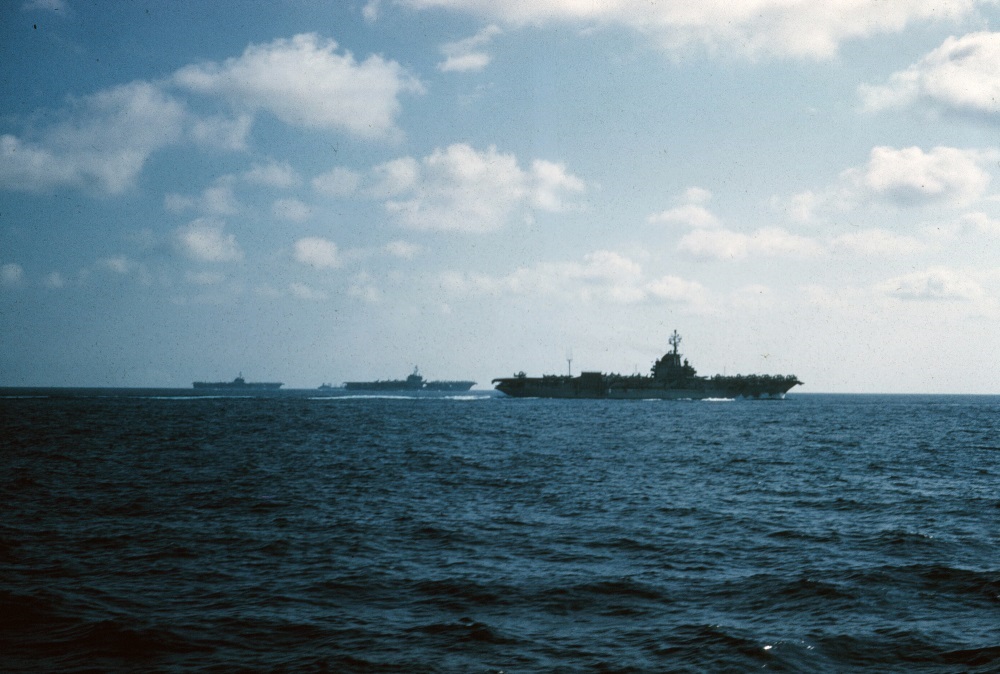 Three aircraft
carriers on Yankee Station
|
The three aircraft carriers on Yankee Station flew different schedules. One carrier flew a twelve hour daylight schedule from just prior to sunrise to just prior to sunset. Another carrier flew approximately the same schedule from 0700 to 1900 (one pinky recovery). The third carrier flew a night schedule from 1900 (pinky launch) to 0700 (pinky to day recovery). That meant that there were two carriers always available to fly strikes in the daytime and one carrier to keep the North Vietnamese up at night. On major "Alpha Strike" days, all three carriers flew the day schedule to be able to bring maximum concentration of our air power for these strikes against Alpha List targets.
We were normally assigned as the day carrier to our lack of two full fighter squadrons and no A6 squadron,
Our Pilots were Ready to Go into Combat over North Vietnam
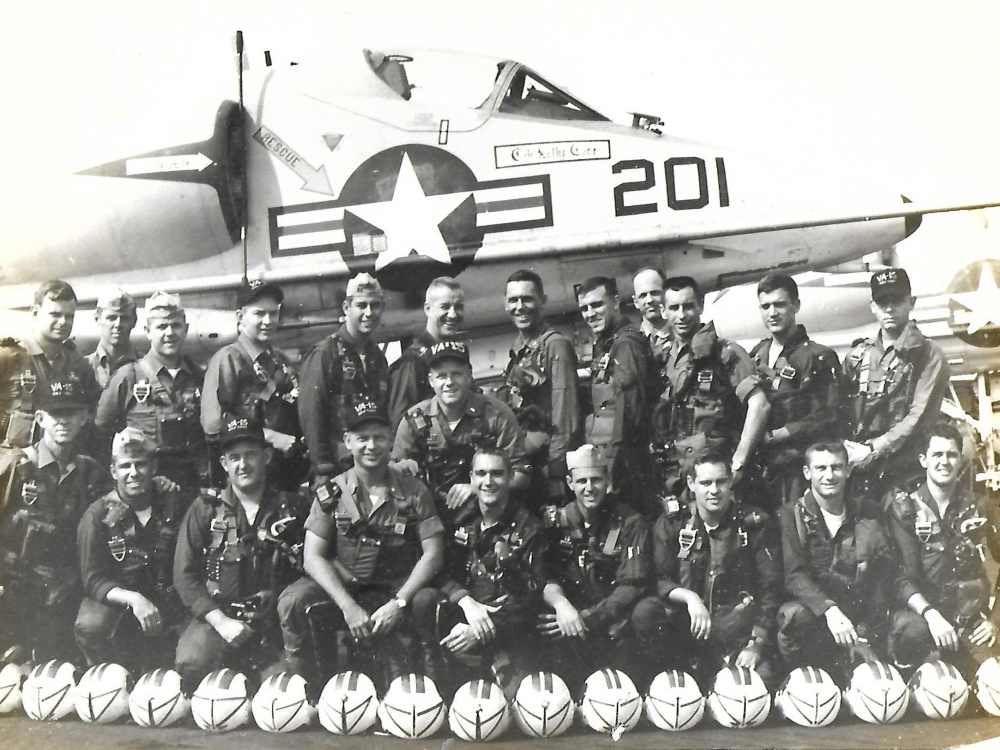 |
| Front Row: Paul
"Black Mac" MacCarthy, Dixie
Culler, Gene "Sid" Atkinson,
Jerry "Possum" Terrell, Bob
Hamel, Keith Strickland,
Dave "Thorny" Thornhill,
Steve Smith, Miller Detrick Back Row: Bob "Cozy" Cole, Dick "Nolts" Nolte, Jerry Tuttle, Ron Gibson, Me, Cdr Kelly Carr (CO), Jim Snyder (XO), Tony Isger, Pete Schoeffel, Ron "Moon" Moreau, Dave "Pars" Parsons, and Ron Gerard |
Missing: Lee Cole, shot down (KIA) June 30th; Phil "P.C." Craig, shot down July 4th (KIA)
This picture was taken after July 4th but before October 4th when Pete Schoeffel was sot down (POW from October 4th until March, 1968) when he was released
VA-15 Second Vietnam Deployment Plaque
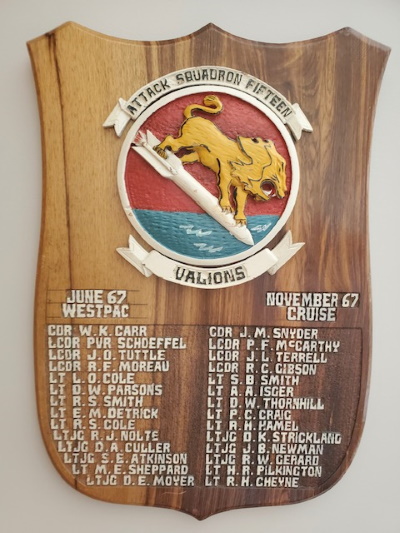 We set out
with the guys on this plaque
except LCDR Paul McCarthy who
joined us later on cruise.
|
Our Aircraft Were Ready to Go Into Combat over North Vietnam
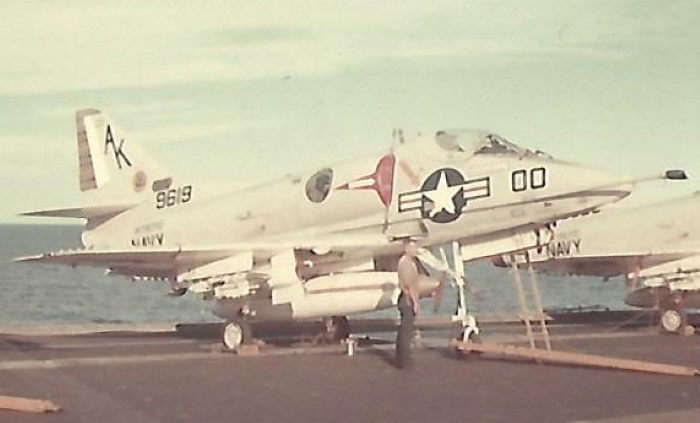 |
| We had 14 A4Cs
fully equipped with ECM
equipment to conduct our
mission as the air wing 10
Iron Hand squadron as well
as for bombing missions. |
I was Ready to Go Into Combat over North Vietnam
 |
Three "bad ass" Valions ready to "kick ass" over North Vietnam
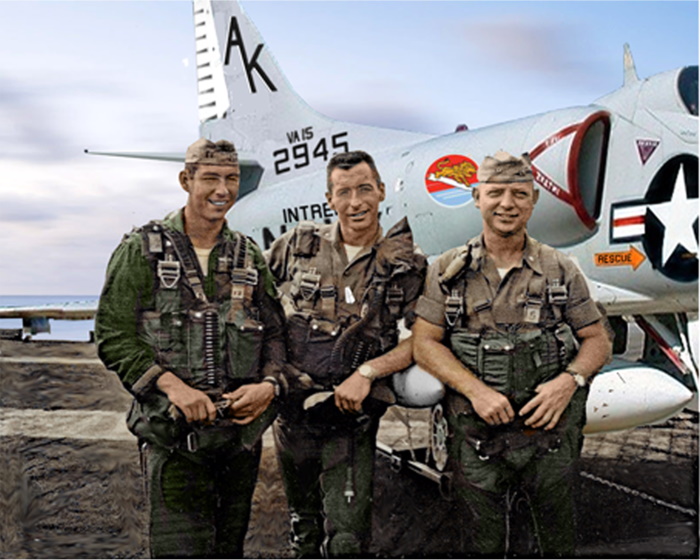 |
| Bo Smith, Moon
Moreau, and Possum Terrell |
Rolling Thunder during the summer and fall of 1967
USAF Operations over North Vietnam
The Air Force flew their F-105 Thunderchief (Thud) strike aircraft and their F4 Phantom fighter support aircraft from bases in Thailand. The Air Force strike packages would normally inflight refuel over Laos and the enter Route Package Five northwest of Hanoi for their strikes. The hills northwest of Hanoi are known as "Thud Ridge" because of the number of F-105s lost there to SAMs and MIGs.
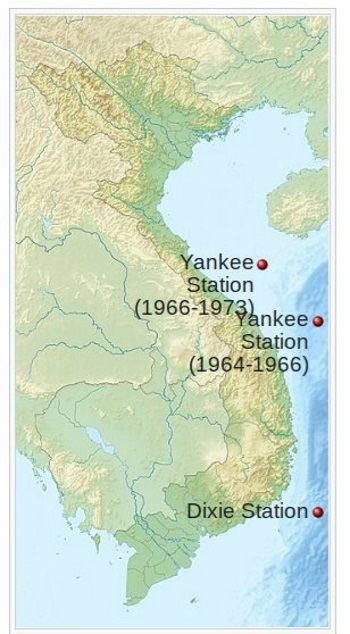 Yankee
Station was actually quite
a bit further north in
June 1967.
|
 Yankee Station was actually about 75 miles east offshore of Thanh Hoa (Route Package 4) when we were on station. The Navy flew missions from Yankee Station in Route Packages 2, 3, 4, and 6B and most of the strikes against Haiphong. The Navy flew some missions in Hanoi coordinated with USAF F-105 missions. The Air Force flew missions in Route Pages 1, 5, and 6A and the majority of the strikes against Hanoi. |
 |
Our First Line Period lasted from June 21st to July 13th (22 days)
In the beginning of our Yankee Station line period, we flew most of our missions in Route Package 2 from the area from Ha Tinh and Duc Tho south of Vinh up through Route Package Three (avoiding Thanh Hoa) and Nam Dinh. Most of these missions were "warm up" type missions in lower threat areas conducting road reconnaissance looking for trucks on the roads or small bridges on Route 1 on the coast or Route 15. The standard bomb load for these missions was a centerline fuel tank with 6 Mk 82 500# bombs three on each wing loaded on a TER (Tripple Ejection Rack).
Replenishment at Sea
We received some critical aircraft parts via the ships COD. But, most of our supplies were loaded aboard while underway from supply ships.
Replenishing Weapons at Sea
We were expending bombs, rockets, and missiles at a high rate while on the line. We had to rearm at sea about every three nights when we were not flying.
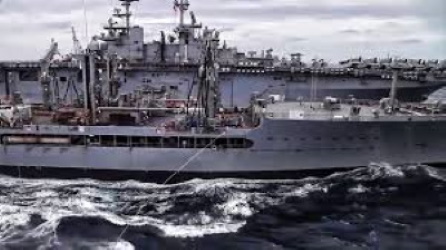 |
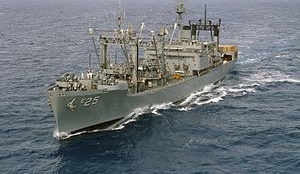 Haleaka
AE-25
|
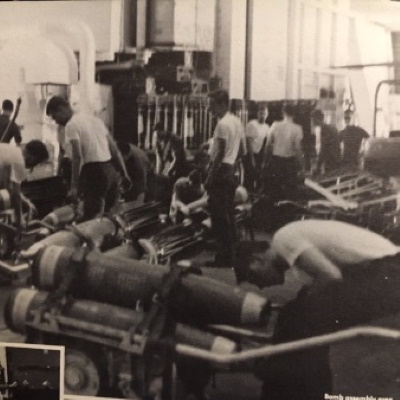 Assembling
MK 82s on the hangar deck.
Snakeye fins in the background. |
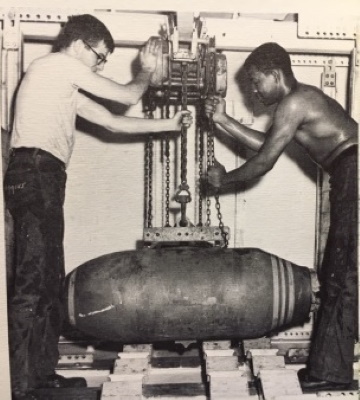 Hoisting an old
non thermally coated
MK 111 Fat Bomb |
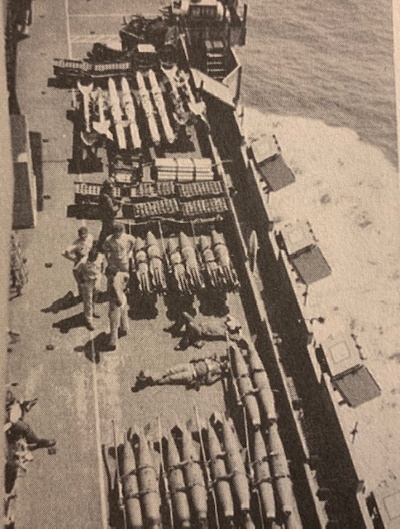 |
We received bombs, rockets and other ordnance from ships like the Haleakala normally every three days while operating on Yankee Station. The bombs would arrive on the hangar deck and be stored or assembled and moved to the flight deck. Some bombs and rockets were temporarily stationed on the starboard side of the island and moved to the aircraft between cycles. |
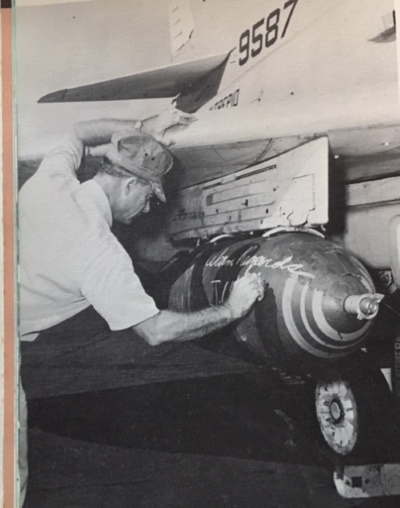 |
Captain Fair, CO of USS Intrepid sending a note to the North Vietnamese. The bomb he is signing is an old non thermally coated 1000# bomb from the Korean War or even possibly the World War II era. With three aircraft carriers flying major strikes at an accelerated pace into North Vietnam, the production of the new thermally coated Mark 80 series bombs fell behind our usage rate and we had to use some of the old non thermally coated bombs until the production rate caught up. |
What is it like to be shot at with AAA?
Barrage Fire-
Barrage fire is a mass of usually light
gray (37mm) or darker gray (57mm) puffs
usually at one altitude generated when the
shell explodes. This is indicative
of non radar controlled fire. The shooters
hope that they have guessed right at the
altitude selected for the shells to self
destruct if they don't get a direct
hit. They select the altitude based
on information from acquisition radars or
oat least on one occasion from observing
the incoming aircraft relative to
targeting balloons (Phu Ly).
Aimed fire- Aimed fire is indicated when the puffs (dark gray for 57mm) or (black for 85mm or greater) are linear in nature. If the radar isn't locked on, the fire normally isn't very accurate. But solid tone in your headset indicates that the Firecan/Flapwheel is locked on and you can expect accurate fire. Then its time to hope your ECM (ALQ 51) gear will cause the radar to lose lock. But, the wise thing to do is to deploy chaff and change your heading and/or altitude. This is called "jinking". You should not jink if its barrage fire because the best way to avoid being hit in barrage fire is to get out of the immediate area quickly by maintaining your heading. Sometimes, that can be difficult to do.
If you are looking at the ground at the source of the AAA, you can see flashes on the ground and if they are using tracer rounds, you can see the rounds coming at you. If the rounds pass close to you, you can feel the sonic boom of the rounds as they pass by. Are we having fun yet!
Aimed fire- Aimed fire is indicated when the puffs (dark gray for 57mm) or (black for 85mm or greater) are linear in nature. If the radar isn't locked on, the fire normally isn't very accurate. But solid tone in your headset indicates that the Firecan/Flapwheel is locked on and you can expect accurate fire. Then its time to hope your ECM (ALQ 51) gear will cause the radar to lose lock. But, the wise thing to do is to deploy chaff and change your heading and/or altitude. This is called "jinking". You should not jink if its barrage fire because the best way to avoid being hit in barrage fire is to get out of the immediate area quickly by maintaining your heading. Sometimes, that can be difficult to do.
If you are looking at the ground at the source of the AAA, you can see flashes on the ground and if they are using tracer rounds, you can see the rounds coming at you. If the rounds pass close to you, you can feel the sonic boom of the rounds as they pass by. Are we having fun yet!
What is it like to be shot at by a SAM?
Normally, your
first indication is a missile launch alert
"warble" from your ECM gear (APR 27).
However, on big strikes, a single alert is
usually accompanied by many alerts as
several SAMs are usually in the air.
Then, it's time to have your "head on a
swivel" looking out for a trail of smoke
heading your way. Usually, if you
can see the SAM coming toward you, you can
lower your nose to keep your speed and G
available and out maneuver the SAM.
Once, it has passed by, you turn back
toward the target and try to gain back
some altitude, check your tail and the 6
o'clock position of the other members of
your flight for the second or third
SAM. If the whole division is the
target, the entire flight may do a split
"S" type maneuver as a flight and then
recover as a flight. Most often though,
the division will loose division
integrity. However, it is critical
to at least maintain section (two
aircraft) integrity. It is the
wingman's responsibility to do so.
Due to our 15,000 to18,000' enroute altitude, we did not experience any losses due to medium altitude barrage 37/57mm fire. We stayed above it! We managed to evade most of the 85mm radar controlled AAA and SAM missiles to and from the target using our EW equipment and proper jinking tactics. Most of our aircraft losses were at the roll in point, during the bomb run or while pulling off the target due to a mixture of aimed radar controlled AAA and dense 37mm/57mm non radar controlled AAA when the bombing aircraft were between 4,000 and 12,000 feet.
Due to our 15,000 to18,000' enroute altitude, we did not experience any losses due to medium altitude barrage 37/57mm fire. We stayed above it! We managed to evade most of the 85mm radar controlled AAA and SAM missiles to and from the target using our EW equipment and proper jinking tactics. Most of our aircraft losses were at the roll in point, during the bomb run or while pulling off the target due to a mixture of aimed radar controlled AAA and dense 37mm/57mm non radar controlled AAA when the bombing aircraft were between 4,000 and 12,000 feet.
USS Intrepid Change of Command (June, 1967)
Underway on Yankee Station
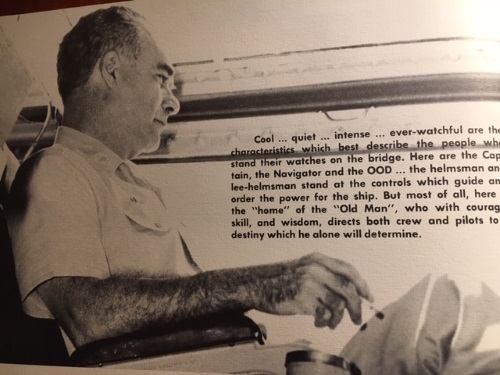 We will miss
Captain Fair !!
We JOs weren't so sure during the 66 cruise when we got to see him up close and personal on the bridge. "The pilot of 306 report to the bridge" Oh no, another tongue lashing from the Captain about a one wire or blown tire. He whipped us into shape and had a lot to do with establishing the professionalism of our air wing which would prove invaluable on the second Vietnam deployment. |
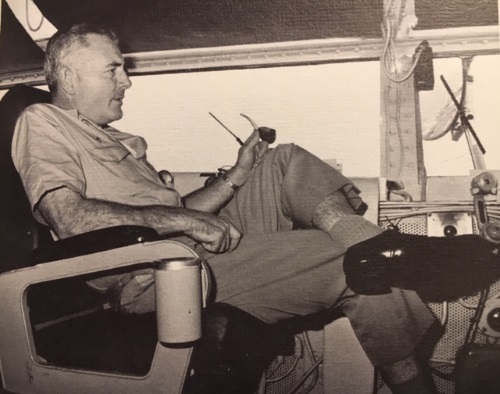 Now it's Captain
McVey's turn!
He's been pretty quiet so far. But, perhaps that is because Captain Fair has handed him a well oiled professional ship and air wing. No one that I know of had been summoned to the bridge so far. But would change for me pretty soon! |
Flight Operations during the First Line Period (June 21st to July 17th)
Our flight operations were
mostly "Cyclic Operations", most of our
targets were Road Reconnaissance
missions to get warmed up at the
beginning .
Cyclic Operations. Cyclic Operations are designed to provide constant air assets available for missions throughout the operating session. The carrier begins the cycle by launching 30 or so aircraft at the start of air operations. An hour and a half or so later, the carrier launches a second group of aircraft and the recovers the aircraft from the first group. This pattern can be continued as long as desired.
Our aircraft were normally configured with a centerline drop tank (2,000 lbs of fuel) which combined with internal fuel ave us 7,400 lbs of fuel which was enough to fly the 1.7 flight time of "Cyclic Ops". Our bomber aircraft were configured with a Tripple Ejection Rack (TER) on each wing station which enable us to carry 6 MK81 (250lb) / MK82(500lb) bombs which was enough for our "Recce" msiions.
We might have been short on MK 80 series thermally coated bombs at the beginning of the line period I only carried 3 MK 82s or MK 81 (250 lb) bombs.
From my log book:
June 21st- 1.7 hours, 3 Mk 82's, 1 Mk 81
June 21st- 1.7 hours, 3 Mk 82s, 1 Mk 81
June 22nd,1.9 flight hours, 3 Mk 82s, 1 Mk 81
June 22nd- LCDR "Possum" Terrell was awarded a Navy Commendation Medal (NCM) for he flew as a section leader on June 22nd. After completing an armed reconnaissance mission, he received an urgent request from the Australian destroyer HMAS Hobart which was receiving fire from a North Vietnamese coastal battery at Dong Hoi. LCDR Terrell located the hostile battery and despite receiving hostile AAA fire, attacked the battery delivering his ordnance directly on target, silencing the threat.

June 23rd (my 26th birthday, 3 Mk82s, 1 Mk 81
Note: We must have received some Mk 81/Mk82s through underway replenishment during the night of June 23rd as we began carrying 6 MK81/82s after that.
June 24th, 1.8 hours, 6 MK 81s
June 27th- 1.1, 6 MK 81s- maybe a small strike of some sort
June 27th- 1.3, no weapons load logged, must have been a "Flex Deck" strike of some kind.
Flex Deck Operations: Flex Deck Operations designed to provide a large number of aircraft to provide enough air assets to strike important well defended targets. Flex Deck Operations, the carrier launches as many aircraft as required to support the missions; sometimes as many as 50 or so aircraft. After the aircraft are launched the flight deck landing area is cleared to receive the aircraft as they return from their missions.
Our aircraft were weapons loads were configured in three ways for Flex Deck Operations:
1. Iron Hand aircraft had a centerline tank and either a Shrike missile on each wing station or more likely a Shrike missile on one wing statioin and a LAU 10 5" rocket pod on the other wing station.
2. Bomber aircraft were still configured with a centerline tank with two TERS loaded with 6 MK 82 bombs. This configuration resulted in flight times of 1.3 hour or so for Flex Deck Operations.
3. Occasionally bomber aircraft were cleaned off (no centerline tank, no TERS; just parent racks) and loaded with a MK 83 (1,000 lb bomb) on each wing station and a MK 84 (2,000 lb bomb) on the centerline station. This configuration can be recognized by flight times of less then an hour; usually .8 or so.
June 27th- Ltjg Nolte flew as a section leader on on a major strike against the heavily defended Nam Dinh transhipment, storage, and rail facilities.
June 28th- 1.2, I flew an Iron Hand section leader support of a strike at Nam Dinh
Note: June 28th- Ltjg Nolte flew as a section leader on another major strike against the heavily defended Nam Dinh target area.
June 29th- 1.9, 3 Mk82s, 1 Mk 81 small strike on Camera ?
June 29th- 1.4, Iron Hand mission in support of a 26 aircraft strike against a petroleum storage area near Haiphong . I was awarded my 2nd NCM with Combat V for this mission.
(I received my 1st NCM during our 1966 cruise)

June 29th- Ltjg Dave "Dixie" Culler flew as a wingman in another Iron Hand section in support of the same 26 plane strike against the Haiphong petroleum storage area. Despite being hit by AAA and fuel streaming from his wing, he continued attacking a SAM site causing it to cease emitting. Dixie was ararded an ndivdual Air Medal for this mission.
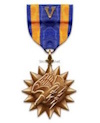
Cyclic Operations. Cyclic Operations are designed to provide constant air assets available for missions throughout the operating session. The carrier begins the cycle by launching 30 or so aircraft at the start of air operations. An hour and a half or so later, the carrier launches a second group of aircraft and the recovers the aircraft from the first group. This pattern can be continued as long as desired.
Our aircraft were normally configured with a centerline drop tank (2,000 lbs of fuel) which combined with internal fuel ave us 7,400 lbs of fuel which was enough to fly the 1.7 flight time of "Cyclic Ops". Our bomber aircraft were configured with a Tripple Ejection Rack (TER) on each wing station which enable us to carry 6 MK81 (250lb) / MK82(500lb) bombs which was enough for our "Recce" msiions.
We might have been short on MK 80 series thermally coated bombs at the beginning of the line period I only carried 3 MK 82s or MK 81 (250 lb) bombs.
From my log book:
June 21st- 1.7 hours, 3 Mk 82's, 1 Mk 81
June 21st- 1.7 hours, 3 Mk 82s, 1 Mk 81
June 22nd,1.9 flight hours, 3 Mk 82s, 1 Mk 81
June 22nd- LCDR "Possum" Terrell was awarded a Navy Commendation Medal (NCM) for he flew as a section leader on June 22nd. After completing an armed reconnaissance mission, he received an urgent request from the Australian destroyer HMAS Hobart which was receiving fire from a North Vietnamese coastal battery at Dong Hoi. LCDR Terrell located the hostile battery and despite receiving hostile AAA fire, attacked the battery delivering his ordnance directly on target, silencing the threat.

June 23rd (my 26th birthday, 3 Mk82s, 1 Mk 81
Note: We must have received some Mk 81/Mk82s through underway replenishment during the night of June 23rd as we began carrying 6 MK81/82s after that.
June 24th, 1.8 hours, 6 MK 81s
June 27th- 1.1, 6 MK 81s- maybe a small strike of some sort
June 27th- 1.3, no weapons load logged, must have been a "Flex Deck" strike of some kind.
Flex Deck Operations: Flex Deck Operations designed to provide a large number of aircraft to provide enough air assets to strike important well defended targets. Flex Deck Operations, the carrier launches as many aircraft as required to support the missions; sometimes as many as 50 or so aircraft. After the aircraft are launched the flight deck landing area is cleared to receive the aircraft as they return from their missions.
Our aircraft were weapons loads were configured in three ways for Flex Deck Operations:
1. Iron Hand aircraft had a centerline tank and either a Shrike missile on each wing station or more likely a Shrike missile on one wing statioin and a LAU 10 5" rocket pod on the other wing station.
2. Bomber aircraft were still configured with a centerline tank with two TERS loaded with 6 MK 82 bombs. This configuration resulted in flight times of 1.3 hour or so for Flex Deck Operations.
3. Occasionally bomber aircraft were cleaned off (no centerline tank, no TERS; just parent racks) and loaded with a MK 83 (1,000 lb bomb) on each wing station and a MK 84 (2,000 lb bomb) on the centerline station. This configuration can be recognized by flight times of less then an hour; usually .8 or so.
June 27th- Ltjg Nolte flew as a section leader on on a major strike against the heavily defended Nam Dinh transhipment, storage, and rail facilities.
June 28th- 1.2, I flew an Iron Hand section leader support of a strike at Nam Dinh
Note: June 28th- Ltjg Nolte flew as a section leader on another major strike against the heavily defended Nam Dinh target area.
June 29th- 1.9, 3 Mk82s, 1 Mk 81 small strike on Camera ?
June 29th- 1.4, Iron Hand mission in support of a 26 aircraft strike against a petroleum storage area near Haiphong . I was awarded my 2nd NCM with Combat V for this mission.
(I received my 1st NCM during our 1966 cruise)

June 29th- Ltjg Dave "Dixie" Culler flew as a wingman in another Iron Hand section in support of the same 26 plane strike against the Haiphong petroleum storage area. Despite being hit by AAA and fuel streaming from his wing, he continued attacking a SAM site causing it to cease emitting. Dixie was ararded an ndivdual Air Medal for this mission.

June30th- 1.6, 1
LAU 10, Vinh, 50 rnds of 20mm. Iron Hand
Section leader for a stike at HaiPhong.
Note: June 30th- Ltjg Nolte flew as a section leader on a major strike against petroleum storage area at Haiphong.
Note: June 30th- Ltjg Nolte flew as a section leader on a major strike against petroleum storage area at Haiphong.
VA-15
lost our first pilot 9 days into the First
Line Period
 |
Lee Cole was shot down on June 30th, 1967 near Vinh
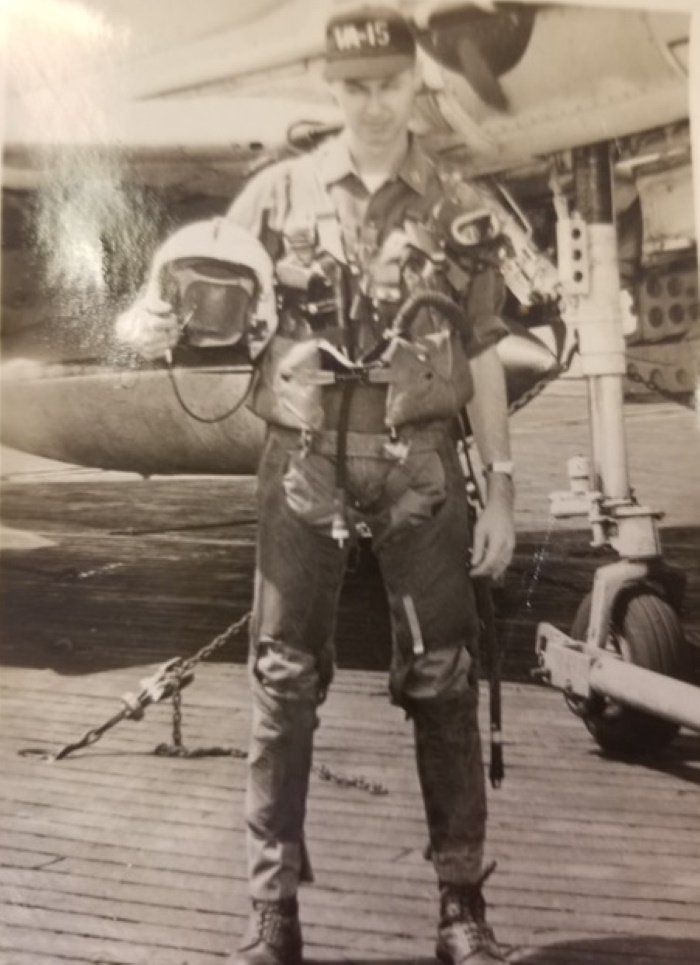 |
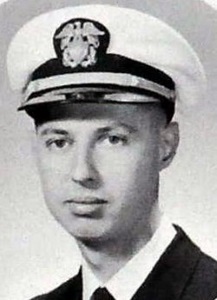 |
Lee Cole was listed as Missing in Action (MIA). His remains were returned by the North Vietnamese On November 3rd, 1988 and identified on March 29th, 1989 at which time he was listed as Killed in Action (KIA). He wife, Billie Jo Cole was very active in the POW Wives Organization both locally in Jacksonville and nationally. |
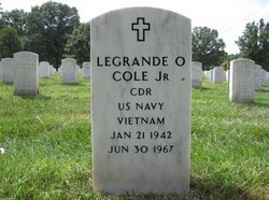 Lee was buried in Arlington National Cemetery on May 5th, 1989 |
 Billy Jo is buried in Arlington National Cemetery alongside Lee in 2010. |
We learned later, the hard way, that Vinh had a very good SAM and AAA defense system. Vinh became known as a location where you didn't get much warning before a SAM launch or very accurate AAA.
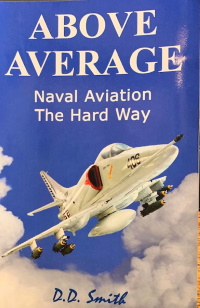 |
D.D. Smith in his book "Above Average: Naval Aviation the Hard Way" describes how most pilots reacted to the combat loss of a fellow aviator. |
"There
was no outward show of
sorrow,
no reminiscences
or eulogies, no
Hollywood
heart-searchings or
phony philosophy- It was
not callousness
or indifference
or lack of feeling for
a comrade who had been
so vibrantly alive
and now was to be a
name on a war
memorial; it was
just that there was
nothing to be said. It was part
of war; men died, more
would die, that
was past, and
what mattered
now was the
business at
hand; those
who lived
would get on with
it. Whatever
sorrow was
felt, there
was no point
in talking or
brooding about
it, much less
in making, for
forms sake, a parade
of it. Better
and healthier
to forget it,
and look for
tomorrow."
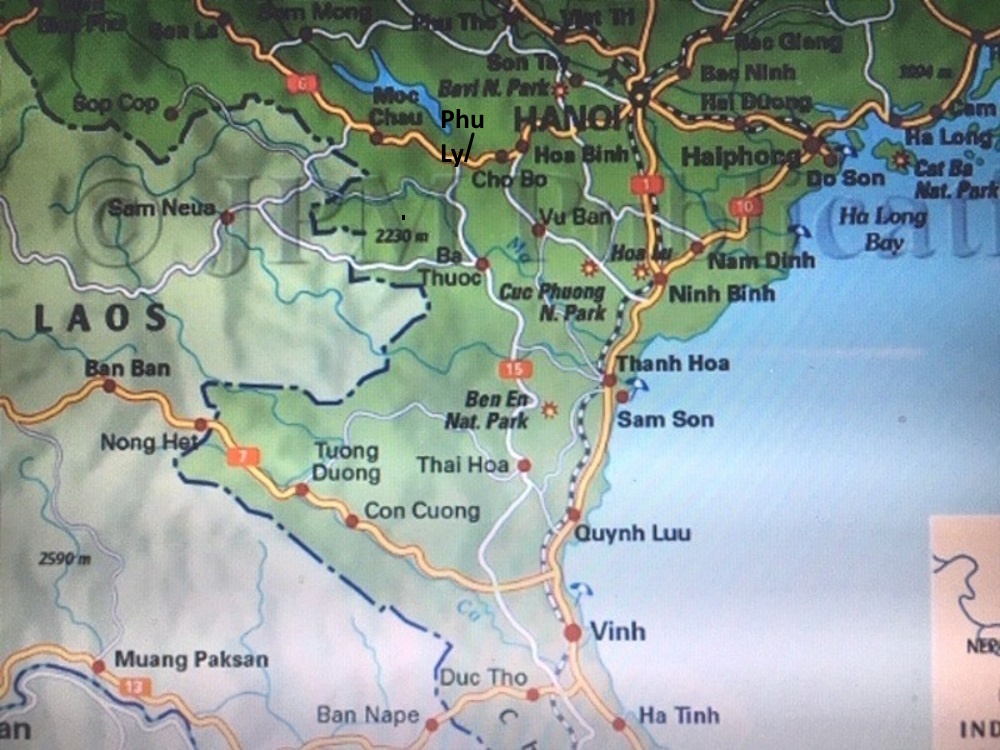
After about a week of warm up missions, we started flying strike missions to targets from Vinh to Haiphong including Ninh Binh, Nam Dinh, and Than Hoa. Yes, the Thanh Hoa Bridge was still standing.
This picture of the Thanh Hoa bridge was taken on May 19th, before we came on Yankee Station.
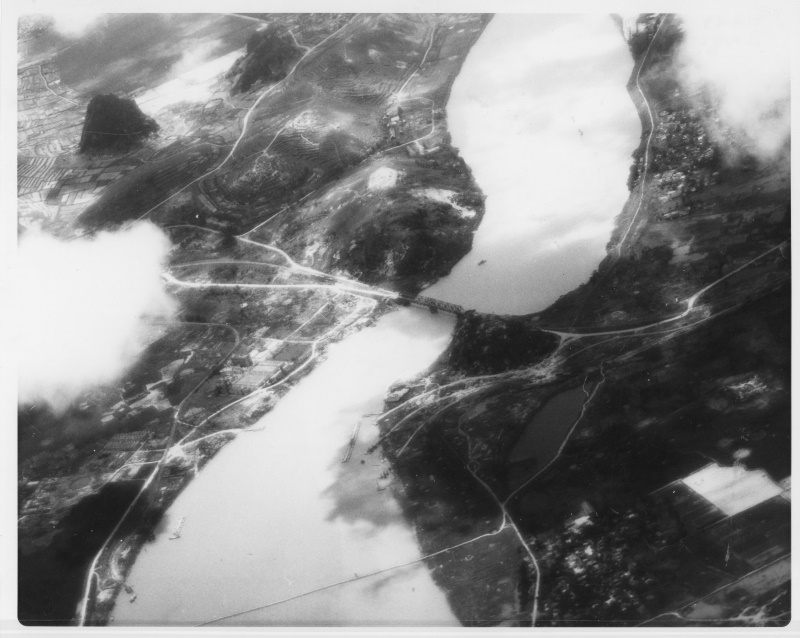 |
Image courtesy of the Lawson Collection, Emil Buehler Library, National Naval Aviation Museum, NAS Pensacola, Florida
As the line period progressed, we began participating in strikes deeper into the Red River Valley toward Hanoi including Phu Ly and to Haiphong and Hai Duong, almost halfway to Hanoi. We flew Iron Hand Anti-SAM missions in support of these strike missions as they were conducted into major concentrations of radar controlled AAA and Surface to Air missiles.
We
flew numerous missions on the Thanh Hoa Bridge.
Despite great hits with our MK 82s, the
bridge although unusable remained
standing.
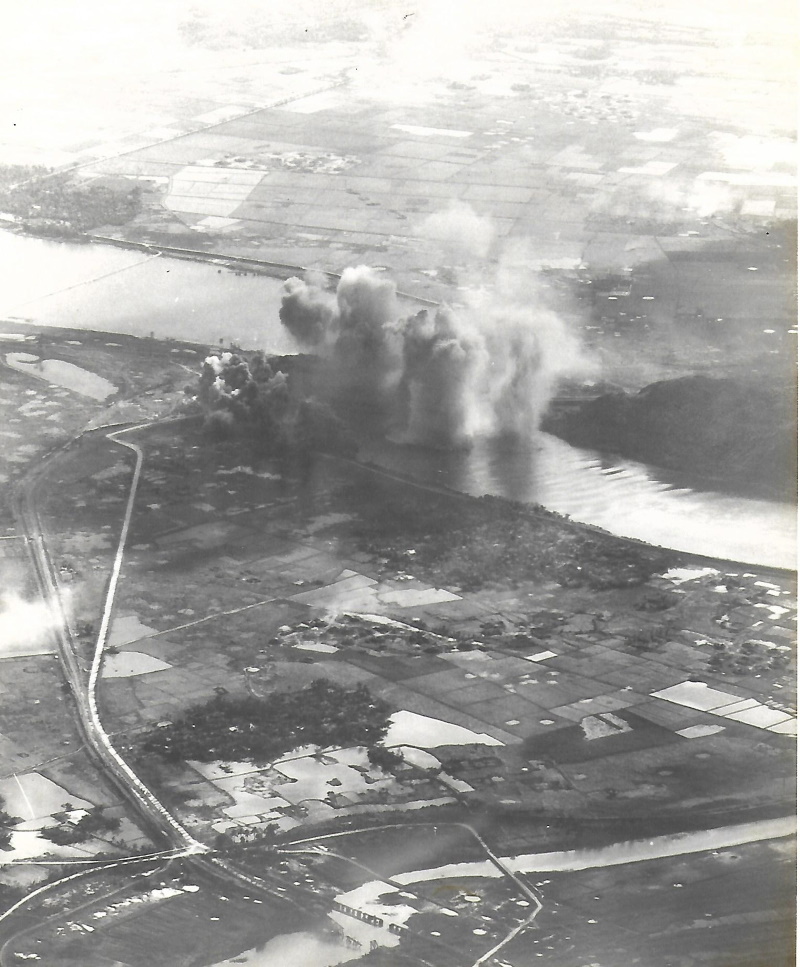 |
When the Thanh Hoa
bridge was unserviceable, the North
Vietnamese used
pontoon
bridges which they used at night to
transport their supplies.
Iron Hand Tactics
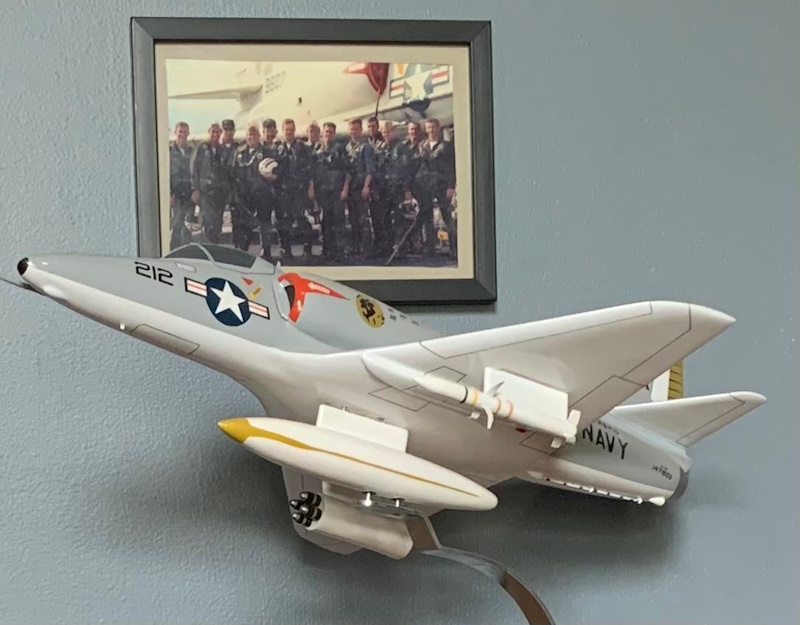 |
| My
model shows our normal
Iron Hand configuration
with an AGM-45 Shrike on
one wing station and an
LAU10 5" Zuni rocket pod
on the other wing station. |
Some airwings choose
to have the Iron Hand (Anti SAM)
and flak suppressor (AAA) aircraft
accompany just in front of the strike group and
react to threats as they came up. Our tactic
was to have the Iron Hand aircraft well out in
front and on
the flanks of the strike group and have
the flak supressors
accompany the strike but be slightly
ahead so that they could attack the known
flak sites just prior to the bomber
aircraft rolling
in.
Our Iron Hand mission aircraft flew in sections of two A4C aircraft. We never broke section integrity on combat missions. We carried a 2000# drop tank on our centerline station. Our A4C had only one weapons station on each wing which limited our weapons load to two AGM-45 Shrikes or one Shrike and eith rockets or bombs on the other. We normally carried one LAU 10 Zuni pod with four 5" rockets on a parent station to keep our aircraft as "clean" as possible and symmetrically loaded.
Oriskany's Iron Hand section consisted of one A4E from VA-164 (which had four weapons stations so could carry twice as many Shrikes as our A4C aircraft) and one F8 C/E as an escort. (Either to provide F8C from VF-111 for TARCAP for MIG protection or an F8E from VFA-152 with bombs and rockets to provide air to ground weapons against the SAM site or associated AAA).
"Early on we {VA-192 Golden Dgragons} teamed up one Shrike pilot {A4E} with one of the fighter jocks {F8 Crusader) from VF-191 or VF-194 and those two flew together all the time" "Alpha Strike Vietnam", Part Three (1966), Chapter 18, The Golden Dragons, page146
This seems at first glance this tactic seems attractive; one Iron Hand pilot who was well trained in attacking SAMs with Shrikes and rockets and a second fighter aircraft that could escort the Iron Hand pilot if he were attacked by MIGs. I like the idea that they teamed two guys to fly together all the time if on an Iron Hand mission. But, to me, the problem with this tactic is what happens if the section is attacked by MIGs. The Iron Hand aircraft doesn't have the performance to stay with the F8. Does the F8 concentrate on the MIG and leave the Iron Hand pilot to press on alone*.
Oriskany had one Iron Hand mission near Hanoi where this situation did occur. In this case, the F8 escort broke section integrity to engage 2 MIG 17s that threatened the Iron Hand section. I wonder, what was the A4E while the F8 escort and the 2 MIG 17s were having at it. Perhaps Mule can give more details on this!
I prefer the tactic that two Iron Hand aircraft fly with sections integrity. If there is a credible MIG threat, then assign an F8 TARCAP/MIGCAP section or two to protect the Iron Hand aircraft from the MIGs.
When I designed the Iron Hand tactics for VA-15, I chose the option that the Iron Hand mission would be mission would be more effective if the SAM sites were engaged before they were able to fire missiles at the strike group. My assumption was that the North Vietnamese Defense Commander would not want to commit to firing his missiles at us. Rather, he would want to conserve his SAMs for the strike group. We thought we could negatively affect his capability by forcing him to not use his Fansong radar if we positioned ourselves to attack the launching site with our AGM 45 Shrikes. I suspect that they had seen the same video as I had of a Shrike missile exploding just above a SA 2 Guideline Fansong van sending thousands of aluminum cubes at high speed into the radar antennae and the van destroying the equipment and killing any operators in the van. Some other airwings also used this tactic.
We would normally coast in at 15,000 feet of altitude. Approaching the coastline, we would be listening for acquisition (Spoonrest or Barlock) radar signals. The North Vietnamese standard procedure was to first detect the azimuth initially detecting the aircraft by using acquisition radar. Next, the enemy would get altitude information by using a conical scan radar (Firecan/Flapwheel). This information was then passed to various AAA sites on the strike's route of flight so that they could set the altitude that their barrage fire would detonate. A well trained pilot could recognize this change. It was also a sign to the Iron Hand section leaders and the Strike leader of the bomber group to increase altitude to be above the barrage fire. At that altuude, the pilot would only be vulnerable to radar controlled AAA of 85mm or greater, SAMs, and MIGs. Our APR 25 was capable of indentifying the 85mm and greater AAA fire control S band radars and our our ALQ-51 EW equipment was capable of breaking the lock on the Firecan/Flapwheel conical scan radars. If we knew we were detected and locked on by AAA rdars, we would execute a change in course every 4 seconds and expend chaff as we intitiated the turn. This tactic was usually effective in that only real threats remaining at above 15,000 were from SAMs and and MIGs. We had BARCAP fighters and PIRAZ and our own TARCAP F8s to protect us from the MIGs. Also, the same rationale applied in my mind that the defense commander would not want to commit his MIGs to the six or eight Iron Hand aircraft when he had 30 to 40 aircraft in the strike group behind them.
Our Iron Hand sections would fly directly to the SAM sites protecting the target area and on the flanks of the strike group course that our intelligence team had told us were occupied with missiles. The North Vietnamese had both fixed and mobile sites. We went to the fixed sites first and reacted to the mobile sites as they became active. We usually had two or three sections of two aircraft each. Each section was briefed on a specific fixed site to start with. We descended to about 15,000 feet (to stay above the 37/57mm barrage fire and observed the site looking to see if they had missiles on the rails. If so, we reported that to the strike leader with calls such as: "Site number xx occupied, Iron Hand One (or Three or Five) Out. That told the strike leader that not only was a prebriefed site occupied but also that we were overhead the site ready to engage it.
The SAM site commander had to bring the E Band Fansong radar online in order to control and detonate the missile. As soon as he did, the Iron Hand leader would commence a dive attack for a "down the throat" Shrike launch. If the missile commander kept the Fansong radar online, his radar van and the people in it were "Toast". The SAM would then self destruct harmlessly. If he shut down his Fansong radar, he cold not control the SAM.
Our Iron Hand mission aircraft flew in sections of two A4C aircraft. We never broke section integrity on combat missions. We carried a 2000# drop tank on our centerline station. Our A4C had only one weapons station on each wing which limited our weapons load to two AGM-45 Shrikes or one Shrike and eith rockets or bombs on the other. We normally carried one LAU 10 Zuni pod with four 5" rockets on a parent station to keep our aircraft as "clean" as possible and symmetrically loaded.
Oriskany's Iron Hand section consisted of one A4E from VA-164 (which had four weapons stations so could carry twice as many Shrikes as our A4C aircraft) and one F8 C/E as an escort. (Either to provide F8C from VF-111 for TARCAP for MIG protection or an F8E from VFA-152 with bombs and rockets to provide air to ground weapons against the SAM site or associated AAA).
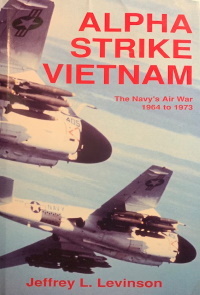 |
"Alpha Strike Vietnam" The Navy's Air War 1964 to 1973 Jeffrey L. Levinson |
"Early on we {VA-192 Golden Dgragons} teamed up one Shrike pilot {A4E} with one of the fighter jocks {F8 Crusader) from VF-191 or VF-194 and those two flew together all the time" "Alpha Strike Vietnam", Part Three (1966), Chapter 18, The Golden Dragons, page146
This seems at first glance this tactic seems attractive; one Iron Hand pilot who was well trained in attacking SAMs with Shrikes and rockets and a second fighter aircraft that could escort the Iron Hand pilot if he were attacked by MIGs. I like the idea that they teamed two guys to fly together all the time if on an Iron Hand mission. But, to me, the problem with this tactic is what happens if the section is attacked by MIGs. The Iron Hand aircraft doesn't have the performance to stay with the F8. Does the F8 concentrate on the MIG and leave the Iron Hand pilot to press on alone*.
Oriskany had one Iron Hand mission near Hanoi where this situation did occur. In this case, the F8 escort broke section integrity to engage 2 MIG 17s that threatened the Iron Hand section. I wonder, what was the A4E while the F8 escort and the 2 MIG 17s were having at it. Perhaps Mule can give more details on this!
I prefer the tactic that two Iron Hand aircraft fly with sections integrity. If there is a credible MIG threat, then assign an F8 TARCAP/MIGCAP section or two to protect the Iron Hand aircraft from the MIGs.
When I designed the Iron Hand tactics for VA-15, I chose the option that the Iron Hand mission would be mission would be more effective if the SAM sites were engaged before they were able to fire missiles at the strike group. My assumption was that the North Vietnamese Defense Commander would not want to commit to firing his missiles at us. Rather, he would want to conserve his SAMs for the strike group. We thought we could negatively affect his capability by forcing him to not use his Fansong radar if we positioned ourselves to attack the launching site with our AGM 45 Shrikes. I suspect that they had seen the same video as I had of a Shrike missile exploding just above a SA 2 Guideline Fansong van sending thousands of aluminum cubes at high speed into the radar antennae and the van destroying the equipment and killing any operators in the van. Some other airwings also used this tactic.
We would normally coast in at 15,000 feet of altitude. Approaching the coastline, we would be listening for acquisition (Spoonrest or Barlock) radar signals. The North Vietnamese standard procedure was to first detect the azimuth initially detecting the aircraft by using acquisition radar. Next, the enemy would get altitude information by using a conical scan radar (Firecan/Flapwheel). This information was then passed to various AAA sites on the strike's route of flight so that they could set the altitude that their barrage fire would detonate. A well trained pilot could recognize this change. It was also a sign to the Iron Hand section leaders and the Strike leader of the bomber group to increase altitude to be above the barrage fire. At that altuude, the pilot would only be vulnerable to radar controlled AAA of 85mm or greater, SAMs, and MIGs. Our APR 25 was capable of indentifying the 85mm and greater AAA fire control S band radars and our our ALQ-51 EW equipment was capable of breaking the lock on the Firecan/Flapwheel conical scan radars. If we knew we were detected and locked on by AAA rdars, we would execute a change in course every 4 seconds and expend chaff as we intitiated the turn. This tactic was usually effective in that only real threats remaining at above 15,000 were from SAMs and and MIGs. We had BARCAP fighters and PIRAZ and our own TARCAP F8s to protect us from the MIGs. Also, the same rationale applied in my mind that the defense commander would not want to commit his MIGs to the six or eight Iron Hand aircraft when he had 30 to 40 aircraft in the strike group behind them.
Our Iron Hand sections would fly directly to the SAM sites protecting the target area and on the flanks of the strike group course that our intelligence team had told us were occupied with missiles. The North Vietnamese had both fixed and mobile sites. We went to the fixed sites first and reacted to the mobile sites as they became active. We usually had two or three sections of two aircraft each. Each section was briefed on a specific fixed site to start with. We descended to about 15,000 feet (to stay above the 37/57mm barrage fire and observed the site looking to see if they had missiles on the rails. If so, we reported that to the strike leader with calls such as: "Site number xx occupied, Iron Hand One (or Three or Five) Out. That told the strike leader that not only was a prebriefed site occupied but also that we were overhead the site ready to engage it.
The SAM site commander had to bring the E Band Fansong radar online in order to control and detonate the missile. As soon as he did, the Iron Hand leader would commence a dive attack for a "down the throat" Shrike launch. If the missile commander kept the Fansong radar online, his radar van and the people in it were "Toast". The SAM would then self destruct harmlessly. If he shut down his Fansong radar, he cold not control the SAM.
 E Band
Fansong radar
|
 Fixed SAM
Site
|
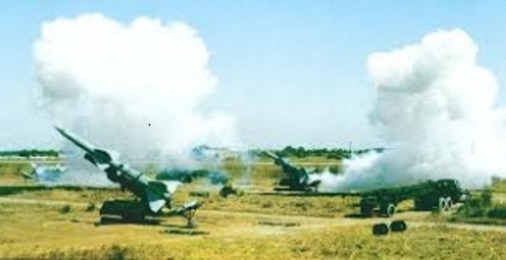 SA 2
Guidline Missiles
|
If we had only one Shrike (due to a
shortage of missiles), we could use a 5"
Zuni rocket from our LAU 10 pod to simulate
a Shrike "down the throat Shrike
shot". Or, we could use Zuni
rockets to attack after our Shrike shot if
we determined that there remaining missiles
and vans in a fixed site. Our Zuni rockets
were also available if there was need for
our services as a RESCAP aircraft. As
we had the centerline tank, we usually had
more fuel than the strike aircraft and could
stay on scene longer. We could return
unused Shrikes and unused or partially used
LAU 10 Zuni pod to the ship and land with no
problem making them available for another
mission.
Note: This tactic had to be changed for Linebacker I in 1972 as the Russians had provided the North Vietnamese a large number mobile quad mounted ZSU 23mm guns. This high rate of fire weapon (the red rope) was very effective upto about 15,000'. So, Iron Hand aircraft couldn't afford to orbit a SAM site waiting for it to fire a SAM. Iron Hand aircraft were forced to fire their Shrikes from a safe distance from the SAM site.
Note: This tactic had to be changed for Linebacker I in 1972 as the Russians had provided the North Vietnamese a large number mobile quad mounted ZSU 23mm guns. This high rate of fire weapon (the red rope) was very effective upto about 15,000'. So, Iron Hand aircraft couldn't afford to orbit a SAM site waiting for it to fire a SAM. Iron Hand aircraft were forced to fire their Shrikes from a safe distance from the SAM site.
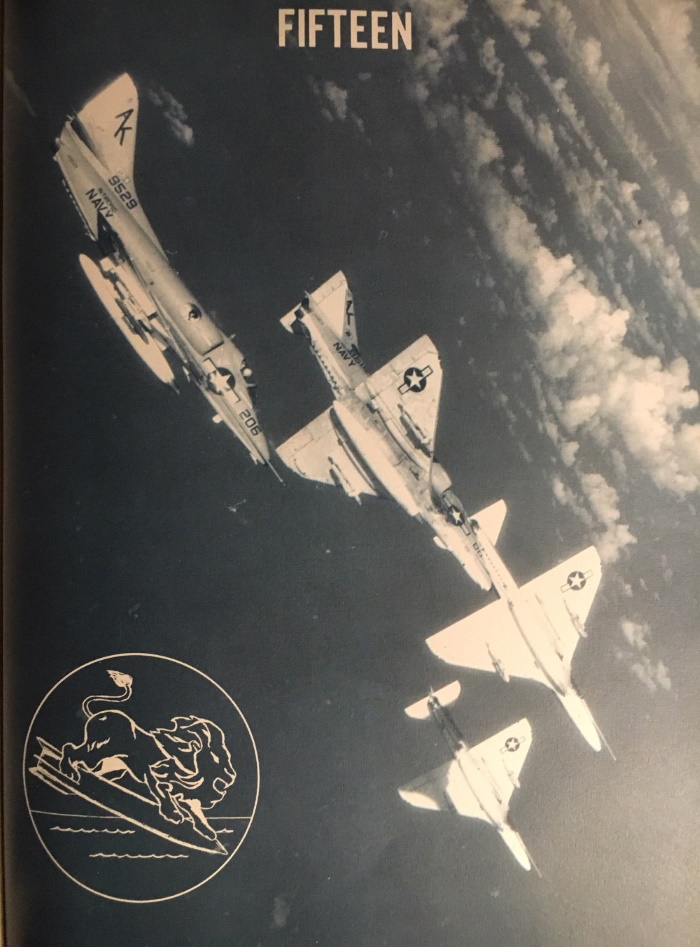 |
The first
two weeks in July were very
difficult
This is one of my combat maps showing some of the primary target areas in Route Pack 6B
We flew a great number of Alpha Strikes in the Hai Duong area. I didn't realize it at the time but this was a significant tactical effort in support the major strategy of Rolling Thunder 57; the isolation of Hanoi and
Haiphong through major strikes against both cities and the lines of transportation between the two.
We knew we were in
for a challenging time because we were
going to be flying missions in Route 6B,
the most heavily defended route package
in North Vietnam except for Hanoi
itself. But we were ready.
We had a core group of flight leaders
and junior officer pilots each with over
100 combat missions. Our new CO,
Kelly Carr, although an experienced
pilot was not combat experienced.
But Kelly's best asset was his great
sense of humor and his willingness to
let the combat experienced division
leaders (Jerry Tuttle, Possum Terrell,
Moon Moreau, Pete Schoeffel) take the
lead in flying most of the strike leads
in the major strike missions until
he gained more combat experience. Our
new XO, CDR Jim Snyder was an
experienced carrier A4 pilot who was a
quick learner in the combat environment.
LCDR "Black Mac" McCarthy was surprised
that he had to fly wing as Number 4 on
experienced JOs from the first
deployment as his section leader until
he got some combat experience. But that
was the rule in VS-15; there was no rank
in the air. The experienced JO section
leaders were the section leaders at
first during our second
deployment. Black Mac and Ron
Gibson became section leaders and
division leaders with time. Our junior officers
with over 100 missions were the "core"
of the squadron. VSF-3 and VA-34 did not
have the flight leaders or experienced
JOs like we had and the air wing
Commander knew it. Therefore, we
were given the most challenging missions
during the Second Line Period.
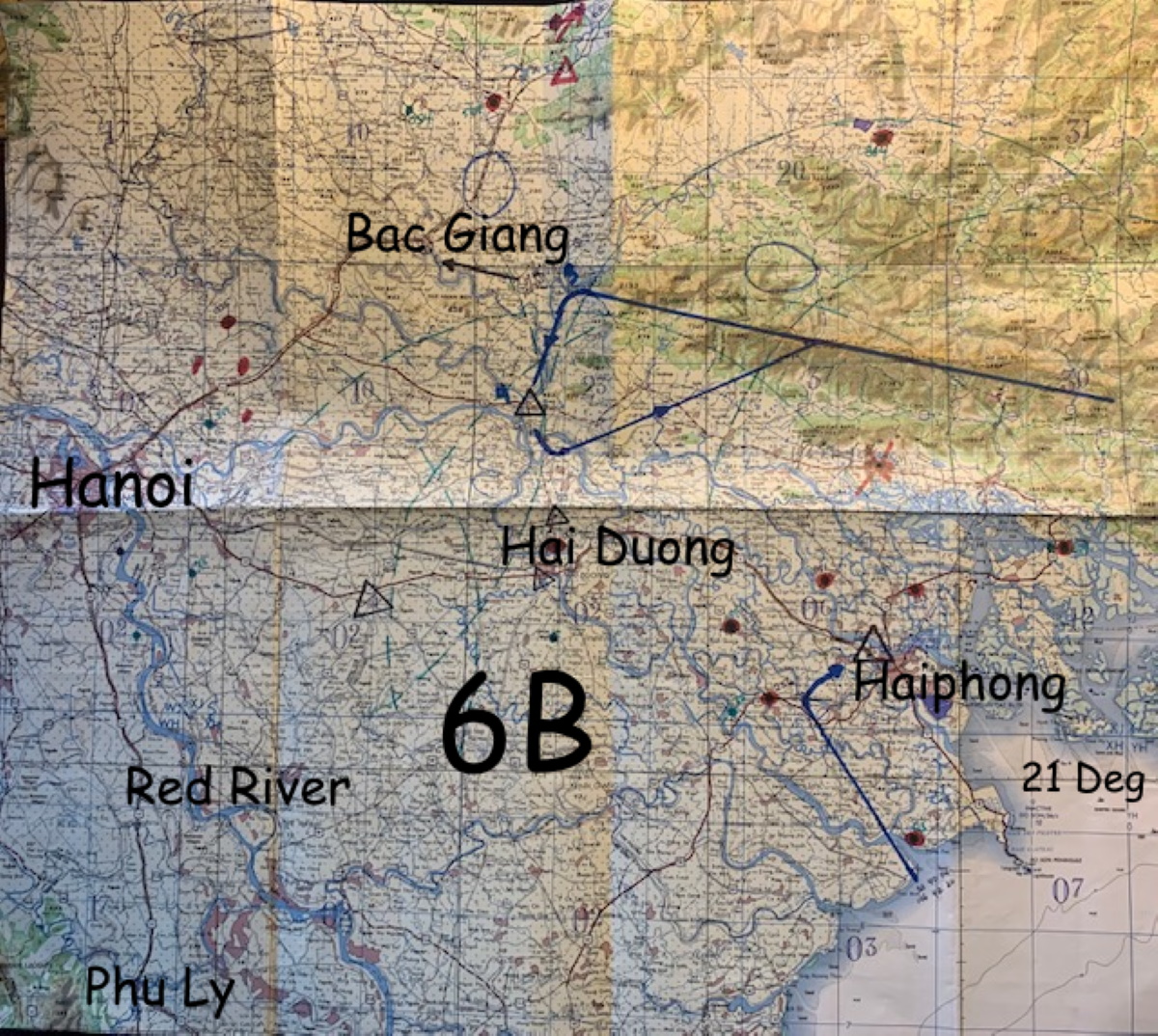 |
This is one of my combat maps showing some of the primary target areas in Route Pack 6B
We flew a great number of Alpha Strikes in the Hai Duong area. I didn't realize it at the time but this was a significant tactical effort in support the major strategy of Rolling Thunder 57; the isolation of Hanoi and
Haiphong through major strikes against both cities and the lines of transportation between the two.
From
my log book:
July 1st- I flew an Iron Hand mission in support of a strike at Ninh Binh (Route Package 4)
July 1st- Ltjg Nolte flew two strike missions on July 1st; the first as a section leader in a strike against a target at Ninh Binh, the second as a section leader against the vital Hai Duong railroad yard between Haiphong and Hanoi.(A Rolling Thunder strategic objective).
July 2nd- I flew an Iron Hand mission in support of a strike at Hai Duong. I fired one AGM 45 Shrike missile.
I was nominated for a DFC for this mission which was downgraded to my 1st individual Air Medal with Combat V.

Ltjg Kasch of VSF-3 was
shot down on this Hai Duong strike
and was not rescued- KIA
July 4th- I flew an Iron Hand mission but did not fire a Shrike.
Ltjg Nolte flew two missions on July 4th; the first as a section leader in a strike against a target at Ninh Binh, the second as a section leader against the vital Hai Duong railroad yard between Haiphong and Hanoi (A Rolling Thunder strategic objective).
July 4th, 1967- LT P.C. Craig did not return from a major strike against the railroad yard at Hai Duong. He was last seen in his dive bomb delivery at the target. His flight leader, LCDR Moon Moreau did not see him resume his normal combat cruise position after rendezvous off the target.
July 1st- I flew an Iron Hand mission in support of a strike at Ninh Binh (Route Package 4)
July 1st- Ltjg Nolte flew two strike missions on July 1st; the first as a section leader in a strike against a target at Ninh Binh, the second as a section leader against the vital Hai Duong railroad yard between Haiphong and Hanoi.(A Rolling Thunder strategic objective).
July 2nd- I flew an Iron Hand mission in support of a strike at Hai Duong. I fired one AGM 45 Shrike missile.
I was nominated for a DFC for this mission which was downgraded to my 1st individual Air Medal with Combat V.

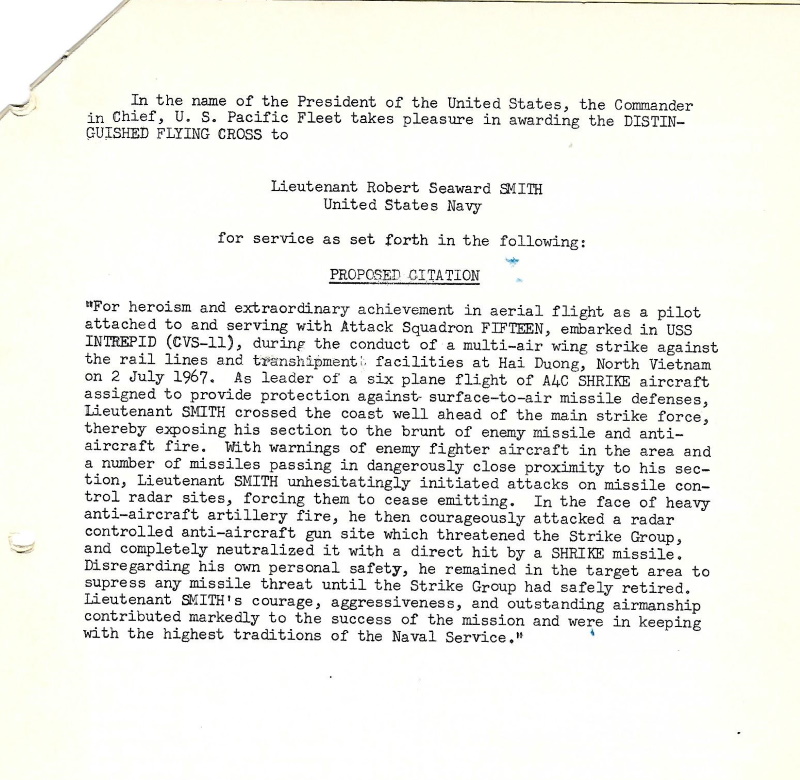 |
July 2nd- Ltjg
Culler flew as an Iron Hand
section leaderof a strike
against the railyard and
transhipment points at Hai
Duong. At first, his section
did not detect any SAM
activity so he decided to
attack an 85mm flak site
that was firing at his
section and was a threat to
the strike group. During
this attack two surface to
air missiles engaged his
section passing close to his
aircraft. Despite this,
Dixie continued his attack
on the gun site silencing
it. He was awarded an
individual Air Medal for
this mission. He might have
been recommended for a DFC
which was downgraded.


July 4th- I flew an Iron Hand mission but did not fire a Shrike.
Ltjg Nolte flew two missions on July 4th; the first as a section leader in a strike against a target at Ninh Binh, the second as a section leader against the vital Hai Duong railroad yard between Haiphong and Hanoi (A Rolling Thunder strategic objective).
July 4th, 1967- LT P.C. Craig did not return from a major strike against the railroad yard at Hai Duong. He was last seen in his dive bomb delivery at the target. His flight leader, LCDR Moon Moreau did not see him resume his normal combat cruise position after rendezvous off the target.
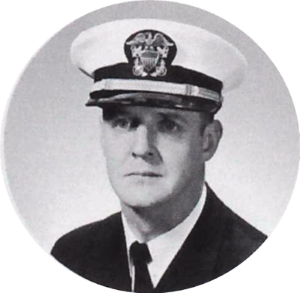 |
LT P.C. Craig was shot down at Hai Duong on July 4th, 1967 His remains were returned by the North Vietnamese in 1985 He is burried in his hometwon of Oneida, NY P.C. Craig was unmaried |
P.C.'s
loss
was a real "kick in the gut" for
those of us who were with him from
the beginning of the new
VA-15. It was even worse for
Dave Parsons who was his roomate
and fraternity brother at the
University of Michigan. They
went through flight training
together. Dave, P.C. and I
used to spend a lot of time
together on the flight deck after
JO chow. P.C. was a member of the
"JO Mafia"!
He was an experienced and skilled combat pilot.
PC's loss was personal and it indicated to us that if P.C. could be shot down, any of us could.
He was an experienced and skilled combat pilot.
PC's loss was personal and it indicated to us that if P.C. could be shot down, any of us could.
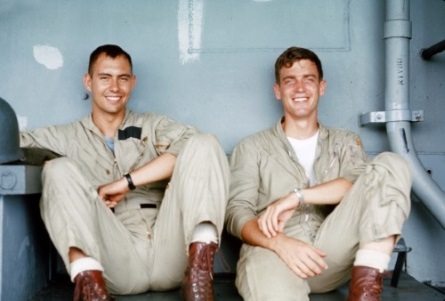 Do you
remember these great smiles on
last cruise.
PC's loss changed this! We were in a fight for our lives now. We all knew it but we would never talk about it. |
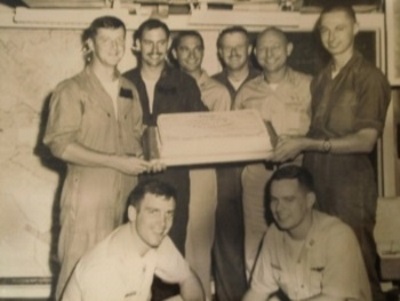 Do you
remember this photo of the 100
trap celebration from last cruise?
(PC on the left and Lee Cole on the right) Two of the eight pilots from Intrepid who were shot down the first two weeks of this line period! |
We had lost that feeling of invincibility that commonly allows young men to perform in risky situations.
We had to replace that feeling with an aggressive warrior professional mentality to survive the next four months!
July 5th, 1967
I flew as a bomber section leader against the Don Son Petroleum Storage Area at Haiphong (4 Mk 82s, 2 MK 81s).
I flew as a bomber section leader against the Don Son Petroleum Storage Area at Haiphong (4 Mk 82s, 2 MK 81s).

This
combat
chart is from the collection of
the Intrepid Air and Space
Museum and is a
gift from the family of LCDR Keith Strickland |
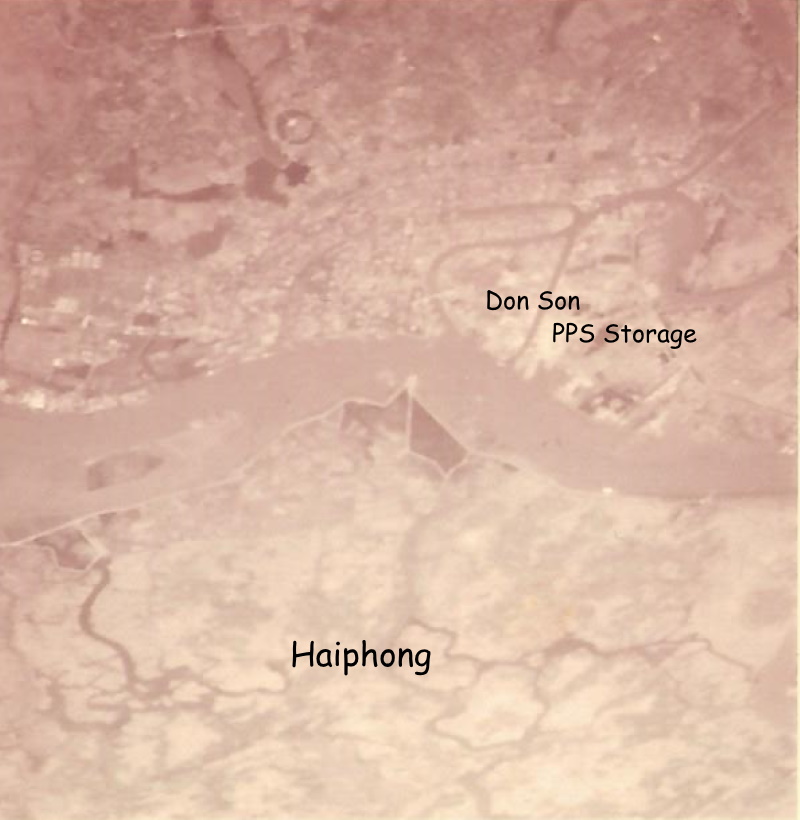 |
I remember pulling out of my dive through the billowing black smoke from the hits of previous aircraft.
 |
| We put a lot of
bombs on target on that
mission! |
I was
awarded an NCM with Combat V for
this mission.

July
5th- LCDR
Jerry Tuttle
received a
Gold Star in
lieu of his
second DFC as
the strike
leader of 22
A4B/C aircraft
against the
railyard and
support
facilities at
Hai Duong.
Desdpite
deteriorating
weather and
heavy AAA,
LCDR Tuttle
navigated his
division to
the target
effectively
delivering
their bombs
causing the
destruction of
three boxcars
and rail line
choke points.
Tut's first
DFC was
awarded for
his strike
lead to Phu Ly
on October
9th, 1966
during our
previous
deployment.

July 5th- Ltjg Nolte flew two Iron Hand missions as a section leader on July 5th; the first was protecting strike aircraft on a restrike of the Don Son petroleum products area that we struck the day before on July 4th. His second Iron Hand mission of the day was protecting the strike group against the railroad yards at Ninh Binh. These two missions were included in his first DFC recommendation dated July 12th.


July 5th- Ltjg Nolte flew two Iron Hand missions as a section leader on July 5th; the first was protecting strike aircraft on a restrike of the Don Son petroleum products area that we struck the day before on July 4th. His second Iron Hand mission of the day was protecting the strike group against the railroad yards at Ninh Binh. These two missions were included in his first DFC recommendation dated July 12th.

I also recorded my 200th trap on Intrepid on July 5th
 |
| Cutting the ceremonial cake with Captain McVey after my 200th Intrepid landing |
July 6th- I flew as a bomber against the HaiDoung RR/Highway bridge or Ninh Binh strikes. (4 MK 82s, 2 MK 81s)
July 6th- LCDR Jerry Tuttle received an idividual Air Medal for as a division strike leader for either the Hai Duong or Ninh Binh strikes.

July 6th- Ltjg Nolte flew a mission as the section leader in the bomber strike group against a railroad just south of Ninh Binh.
July 7th- I flew as a section leader as part of the bomber strike group against railroad yard at Phu LY about 15 miles southeast of Hanoi (4 MK82s, 2 MK 81s)
July 7th- Ltjg Nolte was also a member of the bomber strike group at Phu Ly (4Mk82s, 2Mk81s)
Note: VA-15 provided at least 10 aircraft for the Phy Ly strike group on July 7th (6 bomber aircraft and 4 Iron Hand aircraft). Additionally, VA-15 most likely provided one of the combat mission tankers for the strike. VA-15 routinely provided 10 aircraft for these major strikes for the remainder of our first line period in July. This was only possible through the inspired leadership of the Maintenance Officer, LCDR Tuttle and the hard work of his maintenance personnel. It was particularly amazing considering that the squadron had only 12 aircraft of the originally 14 assigned aircraft due to the two recent losses.
July 8th- I flew again as a section leader in the bomber strike group against at Hai Duong (4 MK 82s, 2MK 81s)
July 8th- LCDR Jerry Tuttle received an Individual Air Medal for leading the srike against either Hai Duong or the Army Barracks at Ban Yan Than (I'm betting on the Hai Duong strike!

July 8th- Ltjg Nolte flew as one of the section leaders of three Iron Hand sections protecting a major strike group against the Army Barracks and Ban Yan Than and an associated SAM missile storage area only seven miles east of Hanoi. This was Intrepids's closest strike to Hanoi during our first line period. Despite the fact that the routes to and from the target and in the target area were protected by 23 known SAM sites, his Iron Hand group were so effective that all the pilots and aircraft returned to Intrepid after a very effective strike. This mission was part of Dick Nolte's DFC recommendation for his July 12th mission!

July 8th- Ltjg Culler also flew as one of the section leaders of three Iron Hand sections protecting a major strike group against the Army Barracks and Ban Yan Than and an associated SAM missile storage area only seven miles east of Hanoi. Quoted from the individual Air Medal award citation by CINCPACLFLT," The success of the strike group in reaching the target in a high threat area, delivering their ordnance on target, and safely returning to the coast was in large measure due LTjg Culler's actions os a missile suppressor."

LCDR Ed
Martin, VA-34 was shot down by a SAM
sometime in July . He
was captured and spent he rest of
the war as a POW. He was
released in February 1973 and went
on to become Commander of the Sixth
Fleet and retired from the Navy
as a Vice Admiral.
From my log book:
July 10th- I flew a bomber mission south of t the DMZ in South Vietnam, 4 Mk 82s
July 11th- I flew a bomber mission and expended 4 MK 82s
July 12th- I flew two missions that day
The first was an Iron Hand mission in support of a strike at Hai Duong. I expended 8 Zuni rocktets from two LAU 10 pods
The second was a bomber mission. I expended 4 Mk 82s and 2 Mk 81s
July
12th- As a
climax to his
series of
arduous and
hazardous
major strikes
in July, Ltjg
Nolte flew as
a section
leader in the
Strike
leader's
division in a
major air wing
strike against
the My Xa
petroleum
products
storage
area
just north of
Hai Duong and
about half way
between Hanoi
and Haiphong.
As
usual, he
demonstrated
his
exceptional
abilities a a
bomber pilot
delivering his
ordnance on
the target
despite the
heavy defenses
in the target
area. |
Ltjg Nolte was recommended for a Distinguished Flying Cross for his exceptional performance as a combat pilot and Iron Hand and bomber section section leader during the missions I have described during our first line period. |
Five other second combat tour VA-15 junior pilots were also recommended for DFC's by Captain McVey, USS INTREPID's Commanding Officer, for missions flown during this line period: Lt Dave Thornhill, Lt Miller Detrick, Lt Bob Hamel, Lt Dave Parsons, and Ltjg John Newman. Unfortunately, I do not know which of these recommendations were approved by higher authority! It is possible that none of these recommendations were approved. DFC recommendations are supposed to be for exceptional performance on a single mission. If these recommendations covered more than one mission, they might not have been approved for that reason.
I will discuss the awards policy later in the chapter.
July 13th- I flew as a bomber section leader on a strike to Hai Duong and expended 4 Mk 117s. Mk 117s were old non thermally coated fat bombs. (my 130th mission). I was recommended for an individual air medal for this flight but after a lengthly administrative delay, it was downgraded to an NCM.

Keeping
Spirits
Positive in the Ready Room
We had only one USO show this Deployment that I can remember.
But it was a good one- Miss America and her troup came visiting at the end of the line period
Relaxing on the flight deck after flight operations were over for the day
I arrived a bit early and noticed a young woman at a table near the bar and decided it was the person I was looking for. But, I was wrong. She was a reporter for an American newspaper. The reporter was quite willing to keep me company but I excused myself when I noticed whom I thought looked like the right person entering the bar. I left the reporter and said hello to Stephanie. She told me that she was a civilian secretary working for the Air Force at Yokota AFB near Tokyo. She even showed me her blue civilian employee DOD ID card.
After a tough couple of weeks on Yankee Station, I needed some TLC. The loss of PC Craig was game changer for me. I felt that the odds were good that I might also be shot down. I needed something to relieve this stress. She provided it. We visited some temples and shrines and experienced some Tokyo nightlife. We had a great couple of days (and nights). I got her official work phone number and returned to Atsugi.
You might wonder why I think it necessary to relate some of the details of this relationship. Well, I think that I would not be honest to not do so. To be sure, I am not relating all the details; just enough to tell my story. I plan to go into this aspect of my life in future chapters because it affected both my professional and personal life significantly.
Also, this is my story and does not imply that anyone else in the squadron did likewise. I think most of the guys in the squadron went on normal liberty associated with the Gulf of Tonkin experience.
We flew our aircraft from Atsugi back onboard Intrepid on July 25th
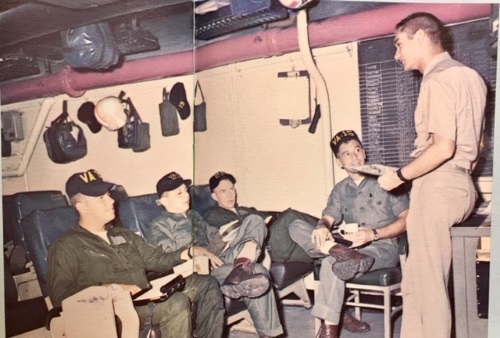 It seems as if Bob Hamel is
always the SDO in these
pictures. Here he is passing out
some information to the next
flight: left to right- Dixie
Culler, Ron Gerard, Ron Gibson,
and Moon Moreau.
|
Fortunately, we had a professional group of pilots and strong support from the ground officers, Chief Petty officers and sailors. The atmosphere in the ready room was always positive. We used humor as a way to keep up our spirits even though we had lost two of our pilots during the second line period. The junior officers had two objects of our practical jokes, both people who took themselves much too seriously: Frog Wigent, the CO of VA-34 and Frenchy LeBlanc, the XO of VSF-3 |
CDR
"Frog" Wigent, CO of VA-34-
Frog was humorless and took himself
way too seriously. We tried to
help him be more cheerful by paying
him special attention. We had one of
those farm sounds play toys that
existed in 1967 in the ready
room. It had a frog selection
that made a frog sound. At
appropriate times, our SDO would
select the VA-34 ready room on the
"bitch box" and pull the string and
out would come the frog sound.
We also purchased frog toys at the
Navy Exchanges and our wives sent a
variety of them. When we got
wind (we had an intelligence network)
of which airplane "The Frog" would be
flying on a mission, we managed to
sneak a toy frog on the seat of his
ejection seat to greet him when he
climbed in. I guess we sort of got
under his skin because he
expressed displeasure on occasion.
There are two more Frog stories to
tell but they will come later.
CDR "Frenchy" Leblanc, XO of VSF-3- Frenchy was also humorless and took himself way too seriously. We tried to help him be more cheerful by paying him special attention. We decided to paint the door of his XO stateroom gold rather that the existing color of VSF-3, red. For some reason, this made him mad. He expressed his displeasure to our CO, Cdr Kelly Carr. Kelly enjoyed telling us how upset he was. Frency had his door repainted and posted a guard (paid a Marine) to watch his door at night. Someone bribed the Marine to leave his station and Frenchy's door was painted gold again. Our slogan "Make Frency's Door Gold Again" (not really, sort of a Trump reference). Frenchy was livid. But, what could he do, tell our CO or CAG that he had paid a Marine to guard his door and those VS-15 JO's painted it gold anyway. CAG would have laughed him out of his office.
Biweekly Cartoon Newsletter- Somehow a weekly or biweekly cartoon newsletter was distributed to the ready rooms and CAG office. Who were the subjects of the cartoons? You guessed right; Frog and Frenchy. I don't actually know who was responsible for publishing the cartoon newsletter but my money is on John "Smedly" Newman.
Note: These morale enhancers continued throughout the cruise and beyond in Frog's case.
CDR "Frenchy" Leblanc, XO of VSF-3- Frenchy was also humorless and took himself way too seriously. We tried to help him be more cheerful by paying him special attention. We decided to paint the door of his XO stateroom gold rather that the existing color of VSF-3, red. For some reason, this made him mad. He expressed his displeasure to our CO, Cdr Kelly Carr. Kelly enjoyed telling us how upset he was. Frency had his door repainted and posted a guard (paid a Marine) to watch his door at night. Someone bribed the Marine to leave his station and Frenchy's door was painted gold again. Our slogan "Make Frency's Door Gold Again" (not really, sort of a Trump reference). Frenchy was livid. But, what could he do, tell our CO or CAG that he had paid a Marine to guard his door and those VS-15 JO's painted it gold anyway. CAG would have laughed him out of his office.
Biweekly Cartoon Newsletter- Somehow a weekly or biweekly cartoon newsletter was distributed to the ready rooms and CAG office. Who were the subjects of the cartoons? You guessed right; Frog and Frenchy. I don't actually know who was responsible for publishing the cartoon newsletter but my money is on John "Smedly" Newman.
Note: These morale enhancers continued throughout the cruise and beyond in Frog's case.
The
Blue
Shoes Award
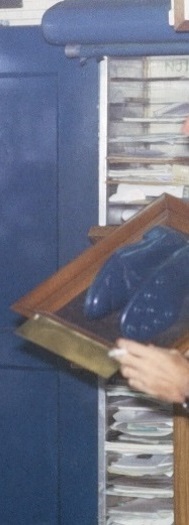 |
We continued the
tradition of the awarding
The Blue Shoes Award to the
officer who "had stepped on
it the most" during
the "End of the Line"
parities or on stand down
days. (about once a
line period) The winner usually received it for some incident "on the beach" (on liberty during in port periods) or something related to the traditional competition for the award between the Senior Officers ("Heavies") and the "JO Mafia". No JOs ever got the award. But, it was very close on one occasion when Black Mac nominated John Newman. The "heavies" made a concerted effort to flip some of the JO vote. But Smeds turned the tables on Black Mac with a brilliant rebuttal speech which resulted in some of the "heavies" voting for Black Mac. I'll give you the "Rest of the Story" a bit later! |
We had only one USO show this Deployment that I can remember.
But it was a good one- Miss America and her troup came visiting at the end of the line period
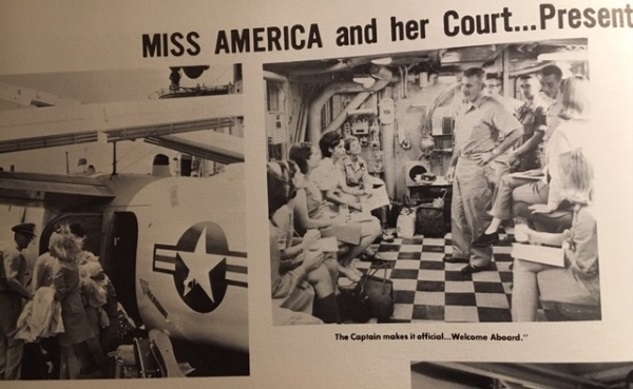 They arrived
by COD.
Captain McVey welcomed them aboard. |
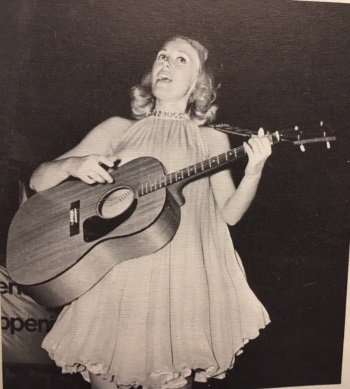 They performed on the
mess decks and visited the
sailors in their work spaces
|
Relaxing on the flight deck after flight operations were over for the day
Because we had a minimal night
capability, we were scheduled as the
day carrier (0700 to 1900). The other
two carriers n Yankee Station rotated
the noon to midnight and the midnight
to noon schedules. With three carriers
on station, there were always two
carrier airwings available for daytime
operations and one for night missions.
July 17th to July 25th-
Intrepid's First Port Visit
(Yokosuka, Japan)We
usually had time after flight
operations for jogging or just
getting together on the flight deck.
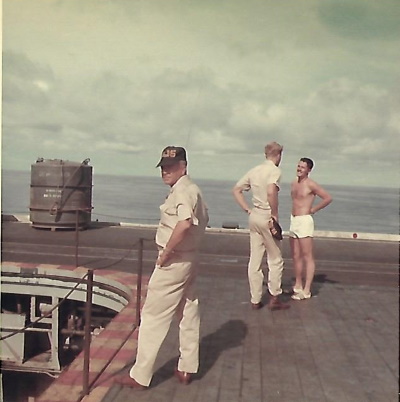 Shep
Shepherd considers his
maintenance
plan for the evening while Miller Detrick and Dave Moyer discuss their exercise plans. |
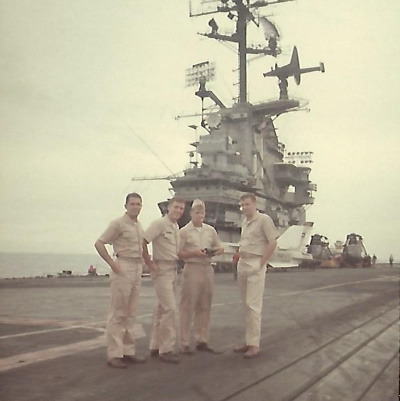 Left
to right: Miller Detrick,
Dave Parsons,
Dixie Culler, and Dave Parsons |
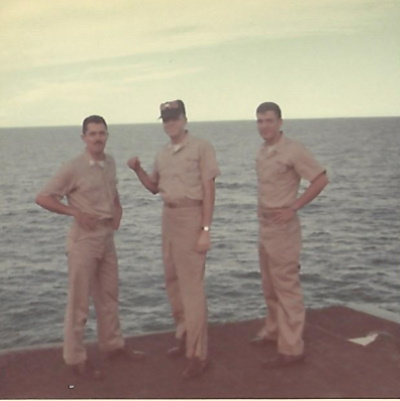 Left
to right: Miller Detrick,
Tony Isger, and Dave
Parsons
|
 |
Our maintenance guys would take advantage of even a short opportunity to remove their shirts and take a break and relax on the flight deck. |
Intrepid
left "the line" about July 14th
and after passing Hainan
Island, steamed north for a port
visit In Yokosuka Japan.
July 17th- I flew A4C 148440 from the ship to NAS Atsugi Japan. (1.1 hours)
July 25th- I flew A4C 149619 from NAS Atsugi to the Intrepid. (1.3 hours)
Several other squadron and airwing aircraft also flew in to Atsugi during the Yokosuka in port period. I don't know how many VA-15 aircraft flew in to Atsugi during Yokosuka port visit. Gene Atkinson remembers flying Jerry Tuttle's wing to Atsugi because he remembers flying around Mt. Fuji.
On this trip, we took a sample of an aircraft part (flap indicator hinge) that we were having problems with. These hinges were made out of aluminum and were failing at a high rate. The flap indicator hinge enabled the pilot to see the position of the flaps on a small guage in the cockpit. In peacetime, this would have resulted in a down aircraft. But, as it was a combat situation, we flew without it. We left the flaps up during taxi on the flight deck and then lowered them to the 1/2 flap position for the cat shot. We knew that the flaps were proper for the cat shot because the final checker used hand signals to confirm we had 1/2 flaps for the launch. We used full flaps for landing. We knew that we had good flaps for landing by the feel of the aircraft and the pilot and LSO could tell by the airspeed/attitude of the plane on final approach.
While we were in Atsugi, a Japanese Company copied the hinges and replaced them with steel. We had about 50 of these hinges manufactured which solved the problem.
I don't know how this arrangement was set up but I expect that this work and the corrosion control/repainting work on our aircraft was coordinated through COMFAIRWESTPAC (Commader Fleet Air Western Pacific) which was located at Atsugi.
Atsugi was a nice change from life on the ship. We stayed at the BOQ and enjoyed beers and steak at the Officer's Club. Most of us got haircuts at the BOQ. We also enjoyed getting a "hotsi bath" or two at the BOQ. It included a steam room, bath by an attendant and a complete massage.
My attendant's name was Nancy. She was attractive in her late 20s. I would meet Nancy again 22 years later during my last tour in the Navy when I was assigned duty at COMFAIRWESTPAC. As a senior Captain, I lived in 06 Quarters on the base with my family. My wife and two daughters (Jessica and Lindsay) and I routinely had family "hotsi baths". Our attendant was 50 year old Nancy.
After a day or so at the BOQ, I decided to go to Tokyo for a few days.
July 17th- I flew A4C 148440 from the ship to NAS Atsugi Japan. (1.1 hours)
July 25th- I flew A4C 149619 from NAS Atsugi to the Intrepid. (1.3 hours)
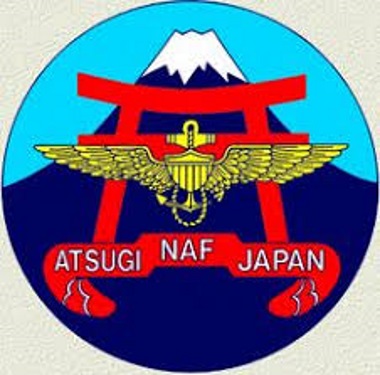 The Nippon Aircraft Company was located on Atsugi Base. All we had lots of corrosion control work done on our aircraft there during our deployment. |
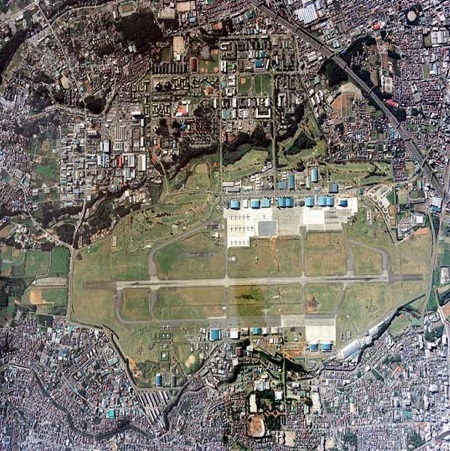 Atsugi
|
Several other squadron and airwing aircraft also flew in to Atsugi during the Yokosuka in port period. I don't know how many VA-15 aircraft flew in to Atsugi during Yokosuka port visit. Gene Atkinson remembers flying Jerry Tuttle's wing to Atsugi because he remembers flying around Mt. Fuji.
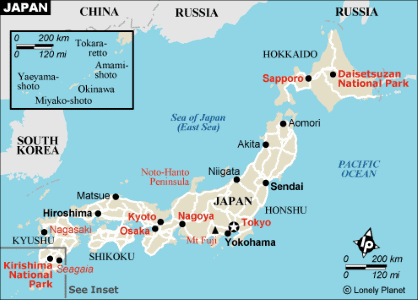 Atsugi is a little
northwest of Yokohama.
Yokosuka Base is a little southeast of Yokohama. |
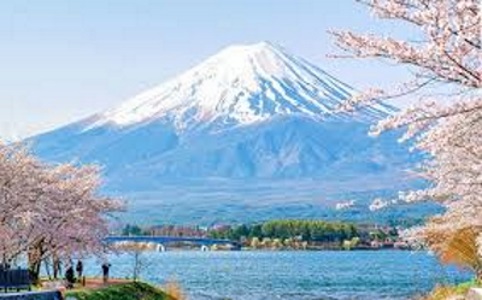 Mt. Fuji is located
west northwest of Yokohama
on the map on the left.
|
On this trip, we took a sample of an aircraft part (flap indicator hinge) that we were having problems with. These hinges were made out of aluminum and were failing at a high rate. The flap indicator hinge enabled the pilot to see the position of the flaps on a small guage in the cockpit. In peacetime, this would have resulted in a down aircraft. But, as it was a combat situation, we flew without it. We left the flaps up during taxi on the flight deck and then lowered them to the 1/2 flap position for the cat shot. We knew that the flaps were proper for the cat shot because the final checker used hand signals to confirm we had 1/2 flaps for the launch. We used full flaps for landing. We knew that we had good flaps for landing by the feel of the aircraft and the pilot and LSO could tell by the airspeed/attitude of the plane on final approach.
While we were in Atsugi, a Japanese Company copied the hinges and replaced them with steel. We had about 50 of these hinges manufactured which solved the problem.
I don't know how this arrangement was set up but I expect that this work and the corrosion control/repainting work on our aircraft was coordinated through COMFAIRWESTPAC (Commader Fleet Air Western Pacific) which was located at Atsugi.
Atsugi was a nice change from life on the ship. We stayed at the BOQ and enjoyed beers and steak at the Officer's Club. Most of us got haircuts at the BOQ. We also enjoyed getting a "hotsi bath" or two at the BOQ. It included a steam room, bath by an attendant and a complete massage.
My attendant's name was Nancy. She was attractive in her late 20s. I would meet Nancy again 22 years later during my last tour in the Navy when I was assigned duty at COMFAIRWESTPAC. As a senior Captain, I lived in 06 Quarters on the base with my family. My wife and two daughters (Jessica and Lindsay) and I routinely had family "hotsi baths". Our attendant was 50 year old Nancy.
After a day or so at the BOQ, I decided to go to Tokyo for a few days.
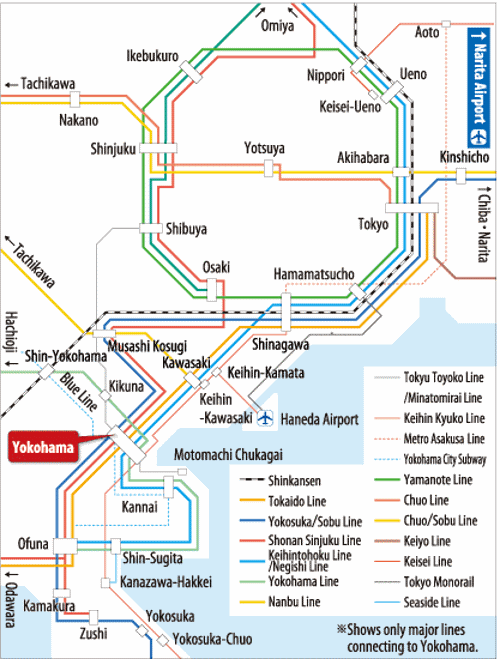 I took the
Yokosuka/Sobu Line (in
dark blue)
|
I stayed at the Old Sanno Military Hotel in downtown Tokyo not far from the Imperial Palace. The Sanno was run by the military as a Field Grade Officer billeting facility. I was able to get a room as a Navy Lt. because I was a combat pilot between line periods. The Sanno was a western style hotel with a great bar and restaurant with affordable rates and prices. Western style hotels in Tokyo were expensive even in those days. I decided to call the American Embassy. I learned from the junior pilots in VF-143 on my 1st Class Midshipman cruise on the Constellation that if you wanted english speaking female companionship, the best thing to do was to call an embassy or consulate of an english speaking country (US, British, or Australian) in a foreign port. All you had to do was tell whoever answered the phone (if they were female) that there were some Navy carrier pilots in town who were looking for a fun time. The response was usually "how many of you are there and where do you want to meet". I called the American Embassy in Tokyo and talked to a young female and she set someone up and a time to meet at the Sanno Hotel Bar. |
I arrived a bit early and noticed a young woman at a table near the bar and decided it was the person I was looking for. But, I was wrong. She was a reporter for an American newspaper. The reporter was quite willing to keep me company but I excused myself when I noticed whom I thought looked like the right person entering the bar. I left the reporter and said hello to Stephanie. She told me that she was a civilian secretary working for the Air Force at Yokota AFB near Tokyo. She even showed me her blue civilian employee DOD ID card.
After a tough couple of weeks on Yankee Station, I needed some TLC. The loss of PC Craig was game changer for me. I felt that the odds were good that I might also be shot down. I needed something to relieve this stress. She provided it. We visited some temples and shrines and experienced some Tokyo nightlife. We had a great couple of days (and nights). I got her official work phone number and returned to Atsugi.
You might wonder why I think it necessary to relate some of the details of this relationship. Well, I think that I would not be honest to not do so. To be sure, I am not relating all the details; just enough to tell my story. I plan to go into this aspect of my life in future chapters because it affected both my professional and personal life significantly.
Also, this is my story and does not imply that anyone else in the squadron did likewise. I think most of the guys in the squadron went on normal liberty associated with the Gulf of Tonkin experience.
We flew our aircraft from Atsugi back onboard Intrepid on July 25th
Intrepid
must have been about 300 miles or
so south of Atsugi because the
flight lasted only 1.3 hours. The
ship returned to Yankee Station on
June 29th and
began combat operations on July
30th.
Oriskany experienced it's first combat loss on their first day on Yankee Station!
July 14th: Combat loss; VA-164. A4E lost, pilot recovered- The aircraft was hit by AAA while attacking barges on a river near Gia La about 15 miles southeast of Vinh. His A4E was hit in the nose and parts we sucked in to the engine. By the time he made it back to Oriskany, his aircraft was on fire. Unable to land aborad, he ejected alongside and was recovered by an SH-2.
July 15th: Combat loss; VA-152. A1H lost, pilot KIA- The pilot was killed during an armed reconnaissance (armed recce) mission along the coast near Thanh Hoa. He began attacking small boats and barges near the village of Hon Ne and was hit by small arms fire from the boats. The pilot radioed that he had been hit. His aircraft crashed into the water shortly thereafter. His remains have not been recovered.
July 16th: Combat loss; VF-162. F8E lost, pilot rescued- The shoot down occurred while three F8E Crusaders were on a flak suppression mission for a strike on a railroad yard at Phu Ly south of Hanoi. Approaching the target, his aircraft was targeted by SAMs. Although he successfully evaded two missiles, a third struck his aircraft as he descended through 5,000 feet. He ejected landing 16 miles from Hanoi. After spending fifteen hours on the ground, most of it in the vicinity of a 37mm gun emplacement, he was rescued by an HS-2 Sea King from USS Hornet.
July 18th: Combat loss; VA-164, 2 A4Es lost, one pilot rescued, one pilot died in captivity- 18 July was a bad day for VA-164 as they struck the bridge at Co Trai. Before reaching the bridge, the section leader LCDR Dick Hartman and his wingman, Ltjg Larry Duthie evaded several SAMs that drove them to lower altitudes. Before they could climb to safer altitude, Dick Hartman was hit by 37mm AAA. With his aircraft on fire, he ejected at 1,000 feet. Because of the successful rescue of the F8E pilot the day before in the same area, a SAR (Search and Rescue) mission was organized while Hartman's wingman, Larry Duthie attempted to orbit over Hartman's position.
Next, Duthie was hit by the same 37mm battery. He headed for the Gulf of Tonkin with his aircraft on fire. Next, both his hydraulic systems failed. However Duthie continued to fly his aircraft as the engine was working and he was able to control the aircraft using trim. He continued for about 12 miles until his Skyhawk became uncontrollable. Duthie ejected near Nam Dinh in a region known as the hour glass (due to the near merge point of two main rivers in Route Pack 6B). Nam Dinh is a small populated area about 45 miles southeast of Hanoi (about 15 miles from Hartman's position.
The North Vietnamese were ready for a rescue attempt for Duthie from the east by Navy assets. As a result, this attempt was aborted due to heavy ground fire. Several helicopters and their fixed wing escorts were damaged. However, the North Vietnamese did not anticipate a second rescue effort from the west. Duthie was eventually rescued by an HH-3 "Jolly Green" helicopter from Detachment 1, 37th Aerospace Rescue and Recovery Squadron (AARS) which was flown from a small "secret" CIA airfield in Laos. On their flight back to Laos, they flew close to Hartman's position. After getting some fuel and fixing up a few holes in their helo they took off to attempt a rescue of Hartman. The weather was good and they knew the position of Hartman. When the AARS helo was closing in on Hartman's location, they asked the Admiral in charge of Yankee Station, call sign "Jehovah" for clearance into the area to make a rescue attempt. The "Admiral comment was, negative "The Navy takes care of it's own so they were forced to abandon the rescue.
This timely at the rescue attempt of Hartman the same day he was shot down had a good chance of success. Hartman was located in a karst ridge west of Ph Ly which was an ideal location for the pick up. The AARS helo command pilot was familiar with the area having recently flown near it. They had radio contact with Hartman on the ground. The North Vietnamese were not well organized yet to find Hartman or to defend the area. However the attempt was not permitted because some "Admiral" wanted the Navy to do the rescue. The decision by "Jehovah" ,CTF 70, to not permit the rescue attempt of Dick Hartman by the AARS helo from Laos the afternoon of July 18th cost Dick Harman his life!.
I am using the names of the pilots involved because not only Peter Fey provides the names but more Importantly both Mike "Mule" Mullane in his book DMF and Larry Duthie in his book "Return to Saigon" provide exceptional descriptions of the events July 18th and use the pilot's names.
July 19th: Combat loss; one A4E from VA-164 lost, pilot recovered, SH3 helo lost, 4 crew members KIA-
This
is a comparison
of the USS
Oriskany's
schedule with
ours, including
details of
Oriskany's
combat and
operational
losses. I
used Peter
Fey's book
"Bloody
Sixteen" and
Mike "Mule"
Mullane's book
"Dead Men
Flying" to
accomplish
this!
I was very interested in reading DMF as Mule was on his "nugget" deployment to Yankee Station with VA-164 aboard USS Oriskany CV-34 and would provide a junior pilot's perspective. It also gave me the idea to try to compare the experience of our "small deck" carrier USS Intrepid with Oriskany, another "small deck" carrier.
In process of trying to document Oriskany's losses, I discovered the Peter Fey had done the job for me in Appendix 1 of his book "Bloody Sixteen". The descriptions of the combat and operational loses experience by Oriskany are almost word for word with a little "wordsmithing" by me on occasion. Thank you, Petr Fey!
 |
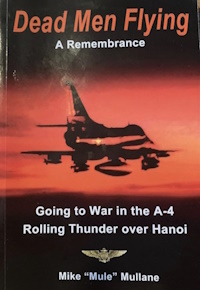 |
I was very interested in reading DMF as Mule was on his "nugget" deployment to Yankee Station with VA-164 aboard USS Oriskany CV-34 and would provide a junior pilot's perspective. It also gave me the idea to try to compare the experience of our "small deck" carrier USS Intrepid with Oriskany, another "small deck" carrier.
In process of trying to document Oriskany's losses, I discovered the Peter Fey had done the job for me in Appendix 1 of his book "Bloody Sixteen". The descriptions of the combat and operational loses experience by Oriskany are almost word for word with a little "wordsmithing" by me on occasion. Thank you, Petr Fey!
Intrepid
and Oriskany
Line Periods
and Liberty
Ports
The are staggered to show where there was some overlap on Yankee Station
1st Line Period June 21st-July 13th
Yokosuka, Japan
2nd Line Period July 30th-August 25th 1st Line Period July 14th-August 7th
Cubi Point/Hong Kong Subic Bay/Cubi Point
3rd Line Period Sept 16th-October 12th 2nd Line Period August 18th-Sept 5th
Sasebo, Japan Sasebo, Japan
4th Line Period Nov 1st-Nov 21st 3rd Line Period October 4th-Nov 3rd
Cubi Point/Home Yokosuka, Japan
Cubi Point/Home Dec 5th-January 11th-4th Line Period
Oriskany/CAG 16 Composition
The are staggered to show where there was some overlap on Yankee Station
Intrepid
Oriskany
1st Line Period June 21st-July 13th
Yokosuka, Japan
2nd Line Period July 30th-August 25th 1st Line Period July 14th-August 7th
Cubi Point/Hong Kong Subic Bay/Cubi Point
3rd Line Period Sept 16th-October 12th 2nd Line Period August 18th-Sept 5th
Sasebo, Japan Sasebo, Japan
4th Line Period Nov 1st-Nov 21st 3rd Line Period October 4th-Nov 3rd
Cubi Point/Home Yokosuka, Japan
Cubi Point/Home Dec 5th-January 11th-4th Line Period
Oriskany/CAG 16 Composition
Squadrons
Aircraft
Type
Number of
Aircraft
Call Sigh
VF-111 (Sundowners) F-8C ? Old Nick
VF-162 (Hunters) F-8E ? Super Heat
VA-163 (Saints) A4E 14 Old Salt
VA-164 (Ghost Riders) A4E 14 Magic Stone
VA-152 (Wild Aces) A-1H/J ? Locket
VAH-Det G (Four Runners) KA-3B ? Holly Green
VFP-63 Det G (Eyes of the Fleet) RF-8A ? Cork Tip
VAW-II Det 34 (Early Elevens) E-1B ? Over Pass
HU-1 Det 1 Unit G (Pacific Fleet Angels) UH-2A ? ?
Note: I only know the number of initially assigned A4Es in VA-63 (14) and VA-164 (14) because Mule mentions the number for his squadron (14) in DMF. I am particularly interested in the number of aircraft initially assigned F8Cs in VF-111 and of F8Es in VF-162.
Mule- Which type of F8 was used to escort your VA-164 Iron Hand aircraft? Or did it depend on the location of the Iron Hand mission; F8Cs where the MIG threat was the greatest ie: Hanoi for Phuc Yen strikes or F8Es for less MIG threat areas where you could use air to ground weapons of the VF-162 F8Es?
VF-111 (Sundowners) F-8C ? Old Nick
VF-162 (Hunters) F-8E ? Super Heat
VA-163 (Saints) A4E 14 Old Salt
VA-164 (Ghost Riders) A4E 14 Magic Stone
VA-152 (Wild Aces) A-1H/J ? Locket
VAH-Det G (Four Runners) KA-3B ? Holly Green
VFP-63 Det G (Eyes of the Fleet) RF-8A ? Cork Tip
VAW-II Det 34 (Early Elevens) E-1B ? Over Pass
HU-1 Det 1 Unit G (Pacific Fleet Angels) UH-2A ? ?
Note: I only know the number of initially assigned A4Es in VA-63 (14) and VA-164 (14) because Mule mentions the number for his squadron (14) in DMF. I am particularly interested in the number of aircraft initially assigned F8Cs in VF-111 and of F8Es in VF-162.
Mule- Which type of F8 was used to escort your VA-164 Iron Hand aircraft? Or did it depend on the location of the Iron Hand mission; F8Cs where the MIG threat was the greatest ie: Hanoi for Phuc Yen strikes or F8Es for less MIG threat areas where you could use air to ground weapons of the VF-162 F8Es?
USS
Oriskany's
First Line
Period, July
14th to August
7th (24 days)
Oriskany experienced it's first combat loss on their first day on Yankee Station!
July 14th: Combat loss; VA-164. A4E lost, pilot recovered- The aircraft was hit by AAA while attacking barges on a river near Gia La about 15 miles southeast of Vinh. His A4E was hit in the nose and parts we sucked in to the engine. By the time he made it back to Oriskany, his aircraft was on fire. Unable to land aborad, he ejected alongside and was recovered by an SH-2.
July 15th: Combat loss; VA-152. A1H lost, pilot KIA- The pilot was killed during an armed reconnaissance (armed recce) mission along the coast near Thanh Hoa. He began attacking small boats and barges near the village of Hon Ne and was hit by small arms fire from the boats. The pilot radioed that he had been hit. His aircraft crashed into the water shortly thereafter. His remains have not been recovered.
July 16th: Combat loss; VF-162. F8E lost, pilot rescued- The shoot down occurred while three F8E Crusaders were on a flak suppression mission for a strike on a railroad yard at Phu Ly south of Hanoi. Approaching the target, his aircraft was targeted by SAMs. Although he successfully evaded two missiles, a third struck his aircraft as he descended through 5,000 feet. He ejected landing 16 miles from Hanoi. After spending fifteen hours on the ground, most of it in the vicinity of a 37mm gun emplacement, he was rescued by an HS-2 Sea King from USS Hornet.
July 18th: Combat loss; VA-164, 2 A4Es lost, one pilot rescued, one pilot died in captivity- 18 July was a bad day for VA-164 as they struck the bridge at Co Trai. Before reaching the bridge, the section leader LCDR Dick Hartman and his wingman, Ltjg Larry Duthie evaded several SAMs that drove them to lower altitudes. Before they could climb to safer altitude, Dick Hartman was hit by 37mm AAA. With his aircraft on fire, he ejected at 1,000 feet. Because of the successful rescue of the F8E pilot the day before in the same area, a SAR (Search and Rescue) mission was organized while Hartman's wingman, Larry Duthie attempted to orbit over Hartman's position.
Next, Duthie was hit by the same 37mm battery. He headed for the Gulf of Tonkin with his aircraft on fire. Next, both his hydraulic systems failed. However Duthie continued to fly his aircraft as the engine was working and he was able to control the aircraft using trim. He continued for about 12 miles until his Skyhawk became uncontrollable. Duthie ejected near Nam Dinh in a region known as the hour glass (due to the near merge point of two main rivers in Route Pack 6B). Nam Dinh is a small populated area about 45 miles southeast of Hanoi (about 15 miles from Hartman's position.
The North Vietnamese were ready for a rescue attempt for Duthie from the east by Navy assets. As a result, this attempt was aborted due to heavy ground fire. Several helicopters and their fixed wing escorts were damaged. However, the North Vietnamese did not anticipate a second rescue effort from the west. Duthie was eventually rescued by an HH-3 "Jolly Green" helicopter from Detachment 1, 37th Aerospace Rescue and Recovery Squadron (AARS) which was flown from a small "secret" CIA airfield in Laos. On their flight back to Laos, they flew close to Hartman's position. After getting some fuel and fixing up a few holes in their helo they took off to attempt a rescue of Hartman. The weather was good and they knew the position of Hartman. When the AARS helo was closing in on Hartman's location, they asked the Admiral in charge of Yankee Station, call sign "Jehovah" for clearance into the area to make a rescue attempt. The "Admiral comment was, negative "The Navy takes care of it's own so they were forced to abandon the rescue.
This timely at the rescue attempt of Hartman the same day he was shot down had a good chance of success. Hartman was located in a karst ridge west of Ph Ly which was an ideal location for the pick up. The AARS helo command pilot was familiar with the area having recently flown near it. They had radio contact with Hartman on the ground. The North Vietnamese were not well organized yet to find Hartman or to defend the area. However the attempt was not permitted because some "Admiral" wanted the Navy to do the rescue. The decision by "Jehovah" ,CTF 70, to not permit the rescue attempt of Dick Hartman by the AARS helo from Laos the afternoon of July 18th cost Dick Harman his life!.
The
Command Pilot
of Jolly Green
37 received an
Air Force
Cross for the
mission.
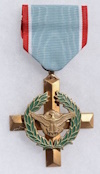

I am using the names of the pilots involved because not only Peter Fey provides the names but more Importantly both Mike "Mule" Mullane in his book DMF and Larry Duthie in his book "Return to Saigon" provide exceptional descriptions of the events July 18th and use the pilot's names.
July 19th: Combat loss; one A4E from VA-164 lost, pilot recovered, SH3 helo lost, 4 crew members KIA-